|
Monday I spent the entire day in my car, reconnoitering the route for the Furnace Creek 508, the two-day cycling race across Death Valley in which I'm participating in early October. If you're ever thinking of riding in the 508, do yourself a big favor and drive the route beforehand yourself. You cannot possibly imagine the distances, heat, desolation, climbs, or beauty without actually being there.
[ Update 8/8/30 - BIG TIME thanks to Chris Kostman, Mr. 508 himself, Chief Adventure Officer and 508 Race Director, who kindly pointed out a number of errors and omissions. I've incorporated his feedback (of course the responsibility for remaining errors remains mine). ]
Before launching into detail, a few impressions. First, the distances are immense, even in a car. I've ridden a lot of double centuries, but this is something else entirely. Second, there is a lot of nothing out there. You will go for mile after mile without seeing any signs of human civilization. You must have adequate food, water, tubes, etc. with you... or in your nearby support vehicle. For large portions of this route there is no cell signal. Communication with your SAG must be via walkie-talkies and/or by having them nearby. Everyone (rider+SAG) has to plan bathroom breaks, fuel and food, sleeping, etc.
Contents
Resources - maps, links, etc.
Overview of the Route - three main parts
Stage 1 - Santa Clarita to California City (82 miles, 6,176 feet)
Stage 2 - California City to Trona (70 miles, 4,212 feet)
Stage 3 - Trona to Furnace Creek (99 miles, 7,538 feet)
Stage 4 - Furnace Creek to Shoshone (73 miles, 6,744 feet)
Stage 5 - Shoshone to Barker (56 miles, 2,186 feet)
Stage 6 - Baker to Kelso (35 miles, 2,920 feet)
Stage 7 - Kelso to [almost] Amboy (34 miles, 2,280 feet)
Stage 8 - Amboy to 29 Palms (58 miles, 4,170 feet)
Projected Schedule
Final Thoughts...
Resources
508 Maps and Route description - PDF document
508 Route in Google Maps - web browser map display
508 Route in Google Earth - Google Earth KMZ file
A great write-up from a SAG perspective, from Matty J. Also check out his blog.
Overview of the Route
The route is divided into eight stages, separated by "time stations". If you are riding in a team, the time stations are where you switch active riders. Here's an overall profile of the route:

Furnace Creek 508 route profile
(click to enlarge)
And here's the Google Maps view of the entire route:
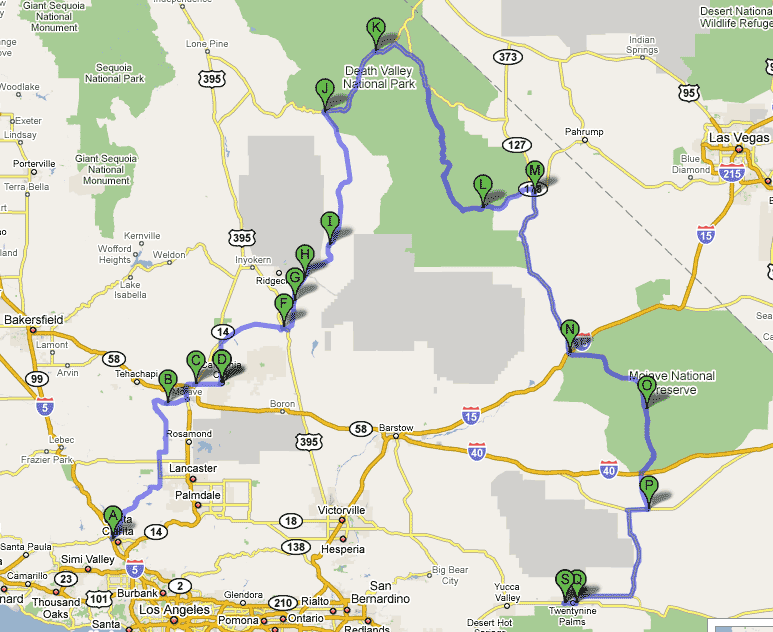
Furnace Creek 508 - overall route map
(click to launch Google Maps)
After driving the route, it seems like it breaks into three main parts - everything before climbing into Death Valley, Death Valley itself (including the two major climbs, one in, and one out), and everything after Death Valley. Here is an overview of those three parts:

Furnace Creek 508 - part 1 - everything before Death Valley
(click to enlarge)
There are some climbs in this section, but mostly it is long rolling sections through desert. The Windmills climb is notable for, well, wind, but since riders will be relatively fresh at this point, it won't be too bad. The climb into Randsburg is gnarly, steep and desolate. But the defining feature of this part is the long distances, particularly after Trona, where you just go mile after mile after mile through the upper desert, until finally you reach the turn at the end of the Panamint Valley that takes you up to the Townes Pass.

Furnace Creek 508 - part 2 - Death Valley, including climb in and climb out
(click to enlarge)
This section is - ta da - Death Valley, punctuated by a long steep climb coming in, followed by a descent, and a long steep climb going out, followed by a descent. Fortunately for the heat the ride sets up so that you'll be in Death Valley at night, but unfortunately you won't be able to experience the beauty; another reason to drive the route beforehand :).

Furnace Creek 508 - part 3 - everything after Death Valley
(click to enlarge)
This section will seem endless - all that riding through the Mojave National Preserve - but at least you'll know you're on the final lap. The climb into Kelso was long but not that steep (easy to say from a car), I suspect the last climb to Sheephole Summit will seem really hard after so much riding, but it wasn't too bad. The biggest problem for this section might be heat, since that whole section through Mojave will be in the middle of the day Sunday.
Stage 1 - Santa Clarita to California City (82 miles, 6,176 feet)
The start, a long stage with two climbs, a nice canyon ride, and lots of flat pounding through the desert:
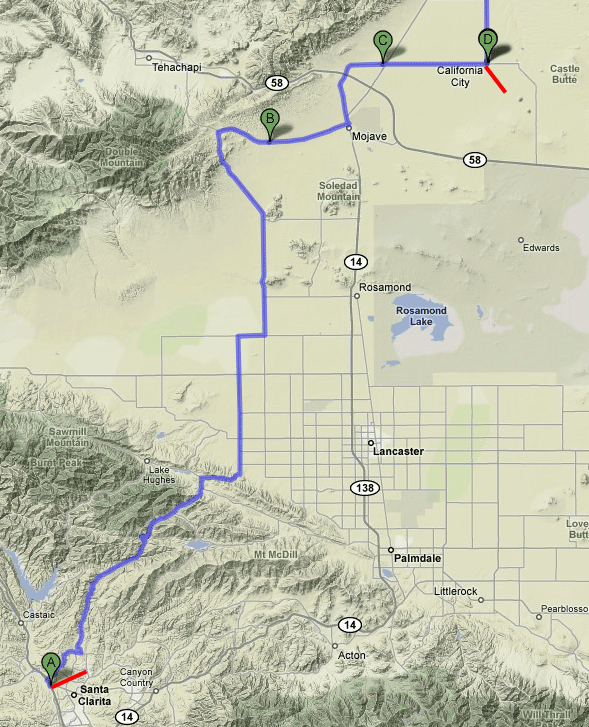
Stage 1 - route map
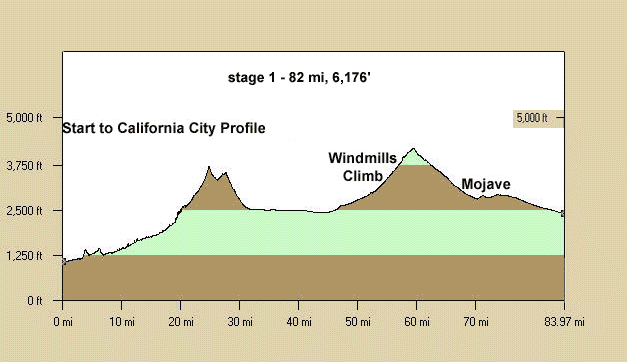
Stage 1 - profile
This stage is the start stage; if you're riding as a team, the whole team starts together. The Hilton Garden Inn is right next to Magic Mountain, and the I5 freeway; it feels pretty different to most of the rest of the ride :) SAG vehicles have to drive on ahead and meet their rider at the 24 mile mark before beginning "leapfrogging" from the rest of the stage. The first five miles are through the bedroom communities along the North edge of Santa Clarita, then there's a left turn and poof you're in Santa Francisquito Canyon.
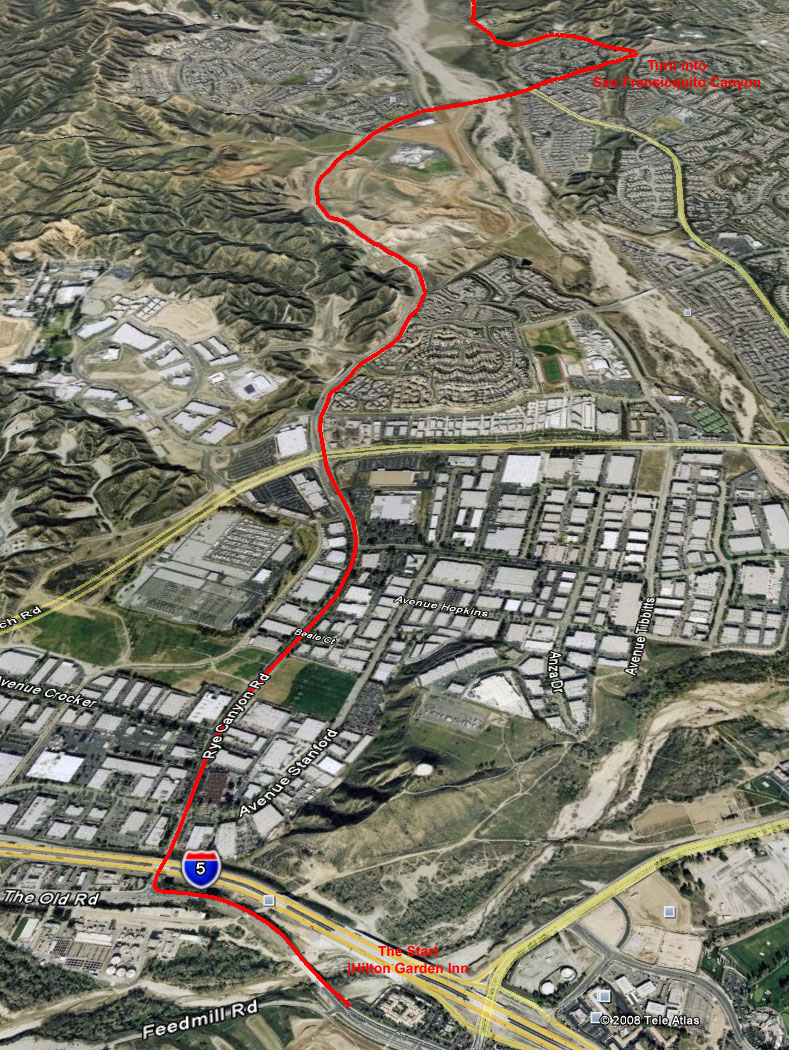
San Francisquito Canyon takes about twenty miles, up and down, mostly up as you climb about 2,000 feet. This is a good road, and not too busy - should be a nice part of the ride.
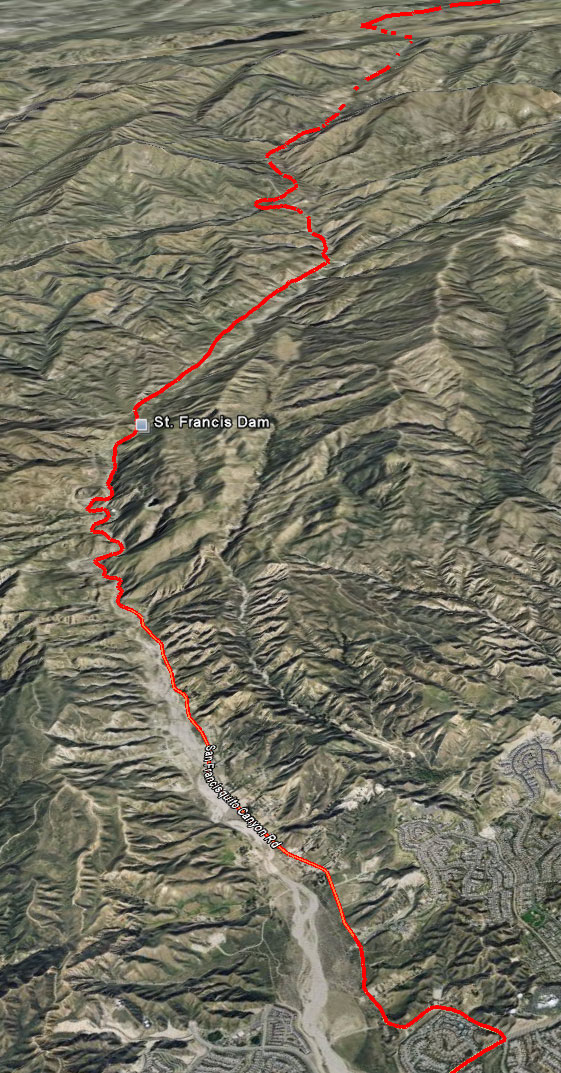
At the end of the canyon there's a nice descent down into the Mojave Desert; you turn right at "the Lakes" and soon find yourself in the middle of flat desert, with nothing but oil derricks.
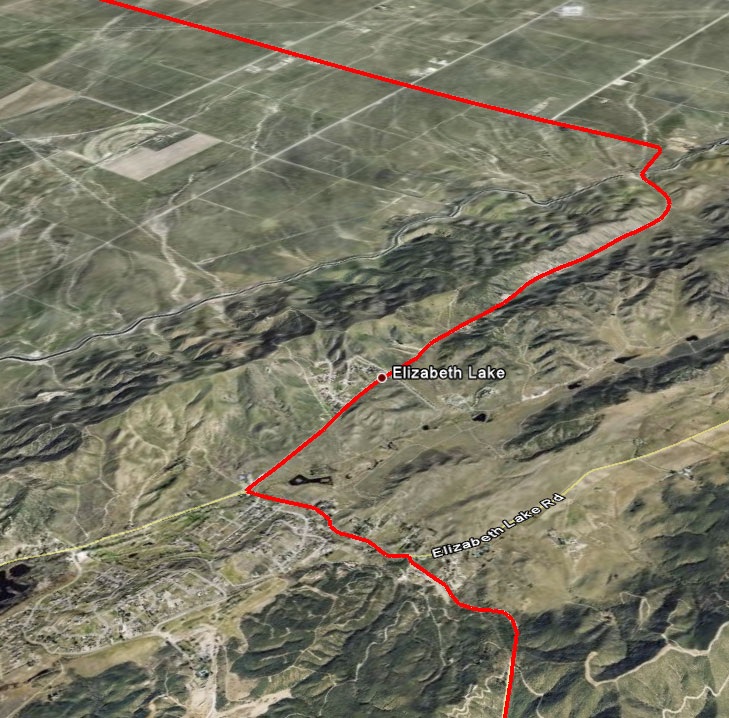
Next up is 20 miles of flat. These are quiet roads in pretty good condition. The only problem might be heat, as the day warms up, and a headwind which builds as you approach the mountains to the North. And boredom...
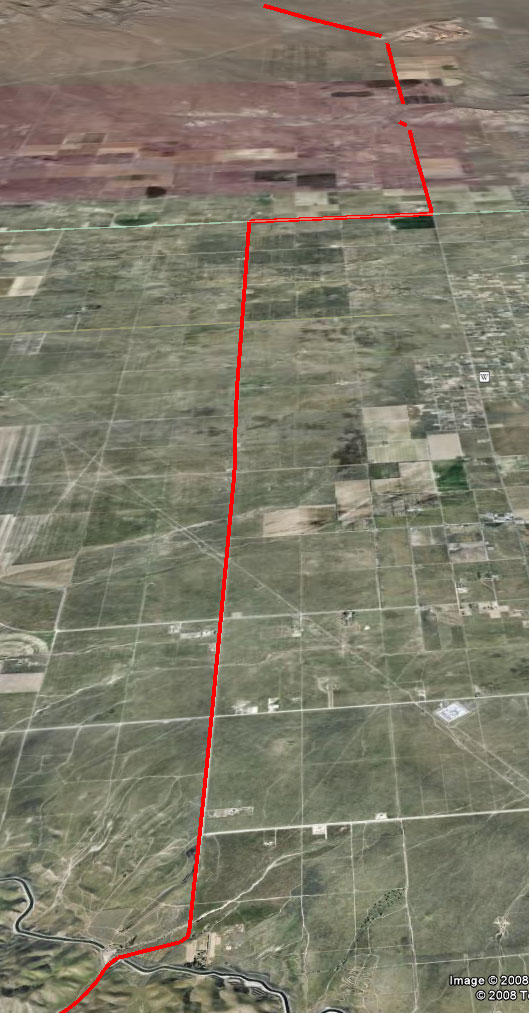
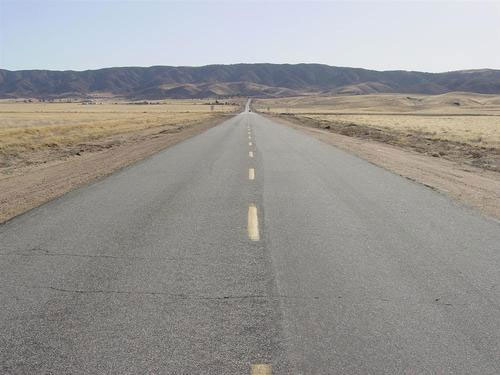
the view North on 110th Street, heading toward the Windmills
(click to enlarge)
Next you come to the "Windmills" climb. This is about 1,000 feet, and not too steep, but there is a reason they put windmills here! You will likely have a stiff headwind all the way up. The only compensation is the 1,000 foot descent on the other side, for which you'll have a nice tailwind :) Both the climb and the descent are about 10 miles.
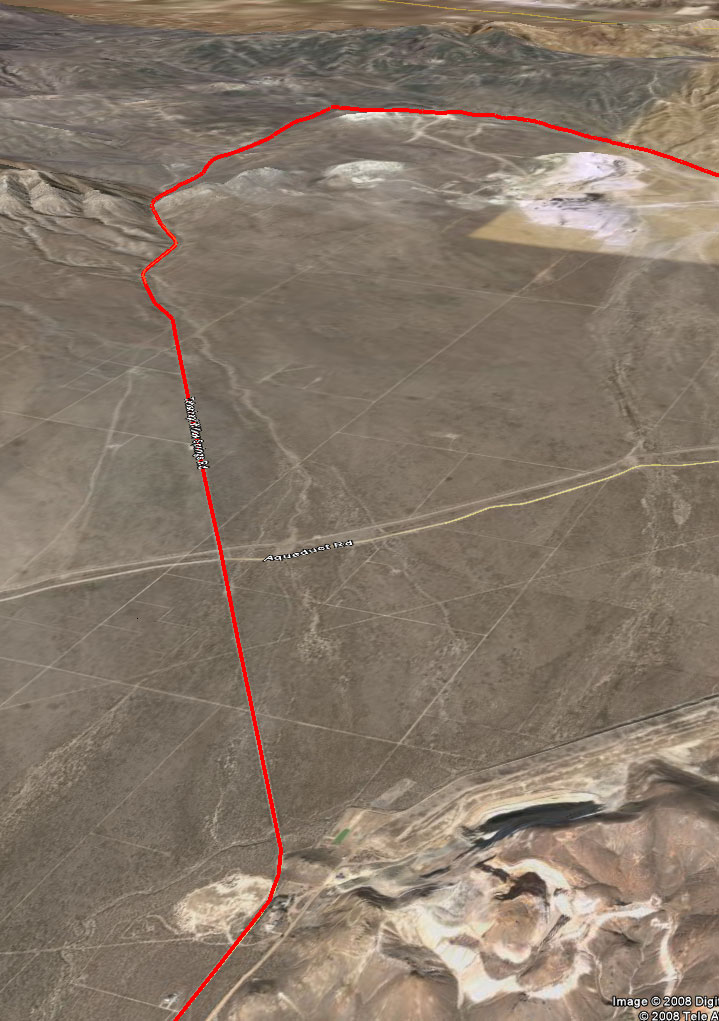
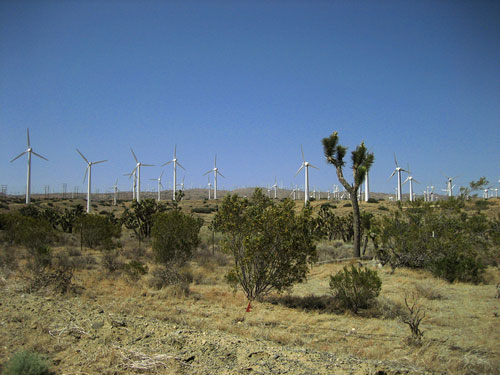
Windmills!
(click to enlarge)
The descent gets you heading East, right at Mojave. You'll skirt the West edge, and [unfortunately] won't be able to see much of the famous "aircraft graveyard" at Mojave airport. The race organizers are trying to keep the riders away from all the truck traffic in Mojave, which is commendable, but still the airport is cool...
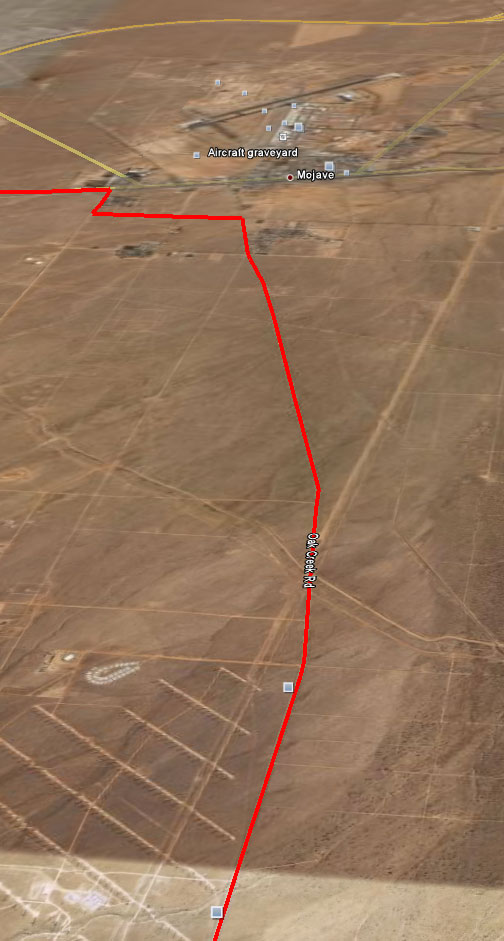

the Mojave aircraft graveyard
(click to enlarge)
That leaves about 15 miles of somewhat-downhill somewhat-tailwind through the desert to California City. This will not be fun as it will now be HOT, and the scenery is rather unexceptional. In the picture below you can see the giant Toyota test track (it dwarfs Mojave airport, which is pretty giant too), but you won't be able to see either from the ride.
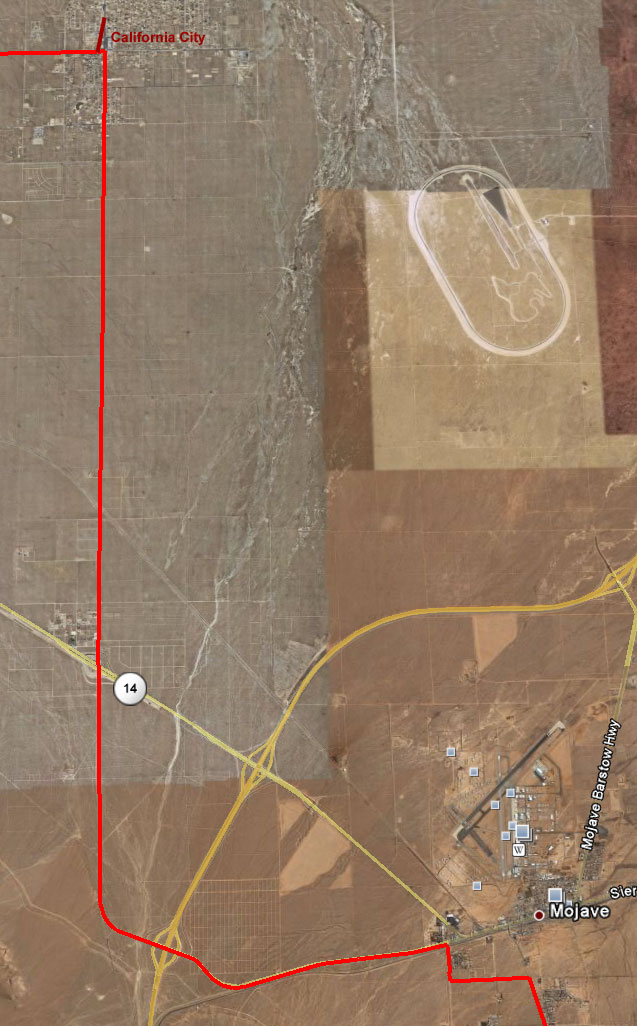
Cal City itself is a nice bedroom community and feels very spread out.
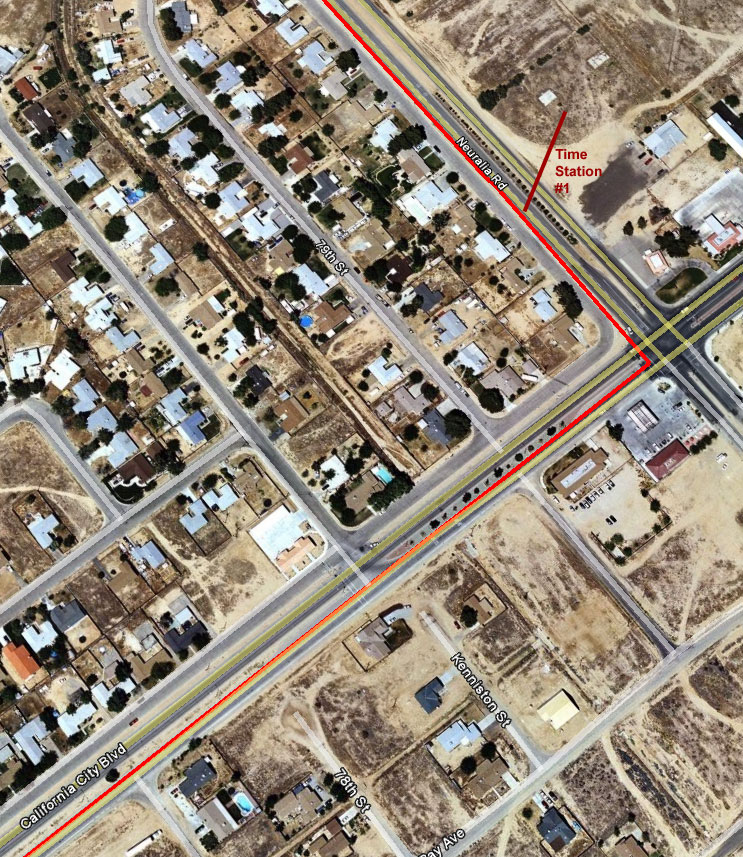
The time station is pretty much on the corner, by that little building; cars park in the dirt lot indicated above, on your right just after turning left on Neutralia Ave. There are plenty of facilities here for buying fuel, food, water, etc. - stock up!
Stage 2 - California City to Trona (70 miles, 4,212 feet)
This stage features more climbing than you might think from looking at the profile, and a lot of desert rollers. Also it is going to be HOT during much of this ride. At least the landscape becomes more interesting as it goes along...
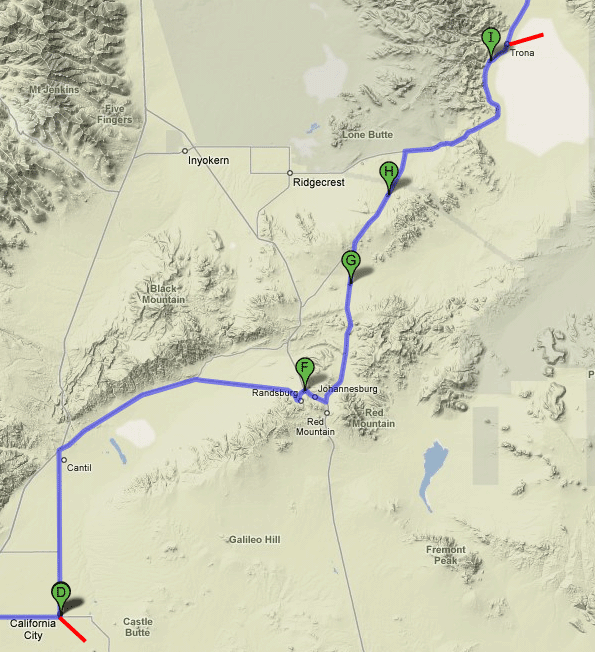
Stage 2 - route map
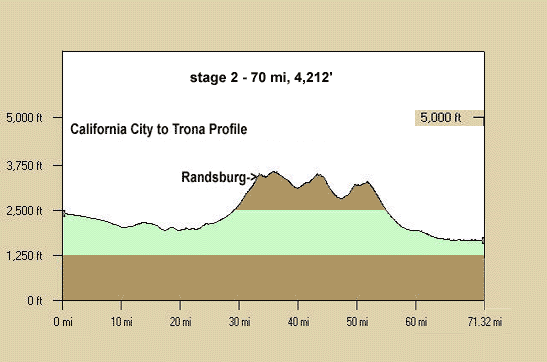
Stage 2 - profile
The stage starts with a straight shot on a flat desert road due North, for about 10 miles. In the picture below you can see the Honda test track, and this you will be able to see from the ride, since you go right by it.
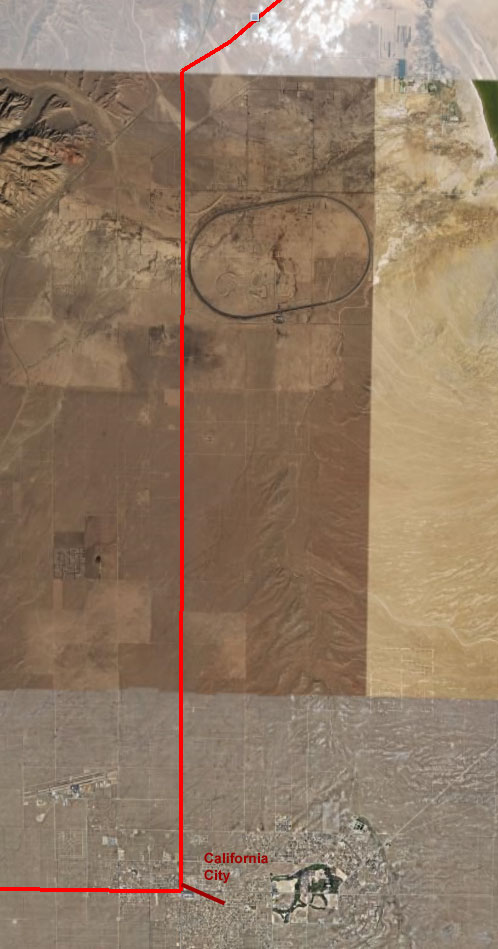
Just before reaching Route 14 you turn right, and then it is another 15 miles of flat desert road, with rock quarries all around. The "flat" might be deceptive as there are rollers here, it gets progressively more difficult as you ride East.
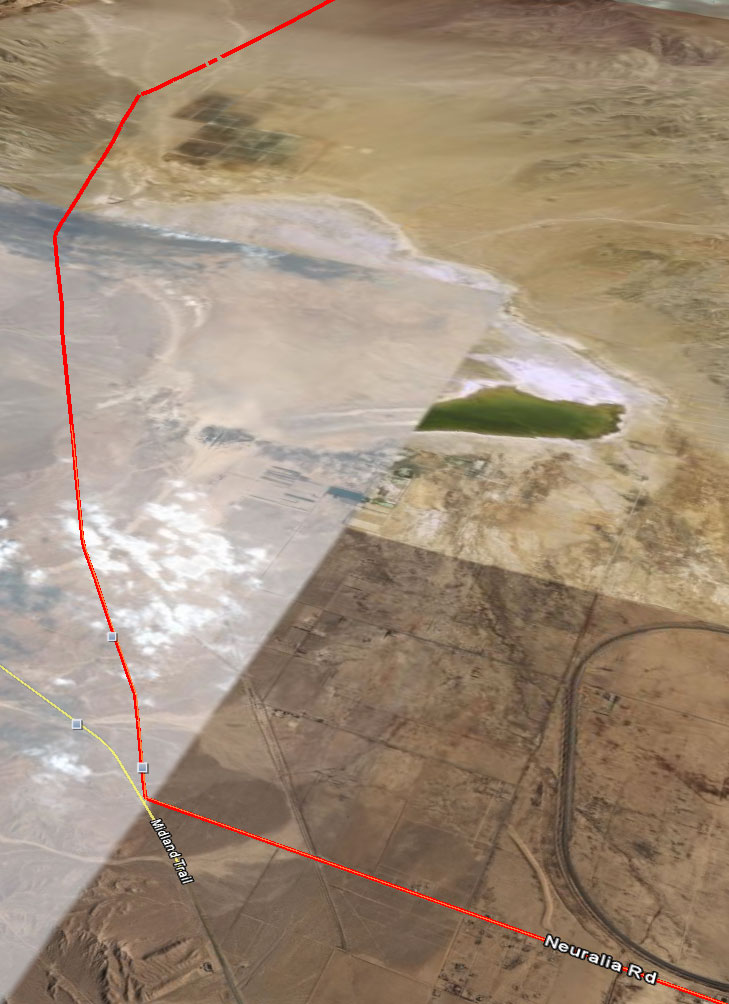
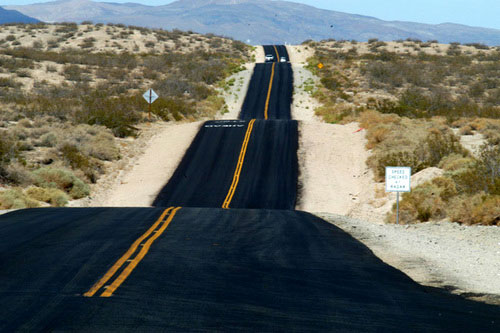
desert rollers
(click to enlarge)
The climb up to Randsburg is worse than it looks on the profile; it is about 1,500 feet, but it gets progressively steeper. The landscape in the canyon you climb is oppressive, it looks like you're entering a rock quarry or something, there are zero plants. The road surface seemed pretty good, fortunately, although it might get sticky in the heat.
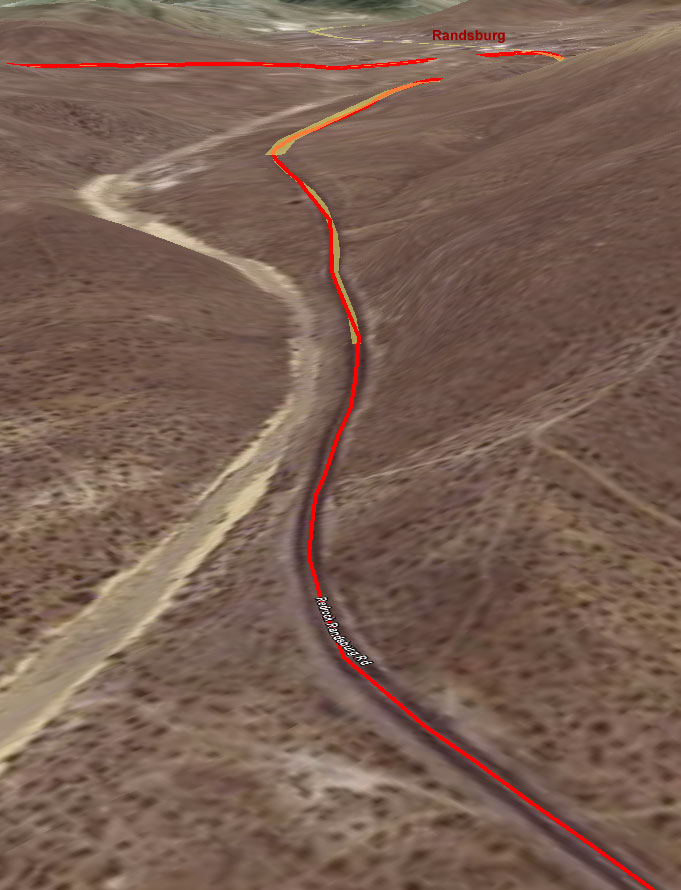
Randsburg is a weird place in the middle of nowhere. It feels desolate and friendly all at the same time; many of the buildings look abandoned, yet it doesn't feel like the place is dying. Anyway so you turn left upon entering the town, leave it, and enter serious roller territory.
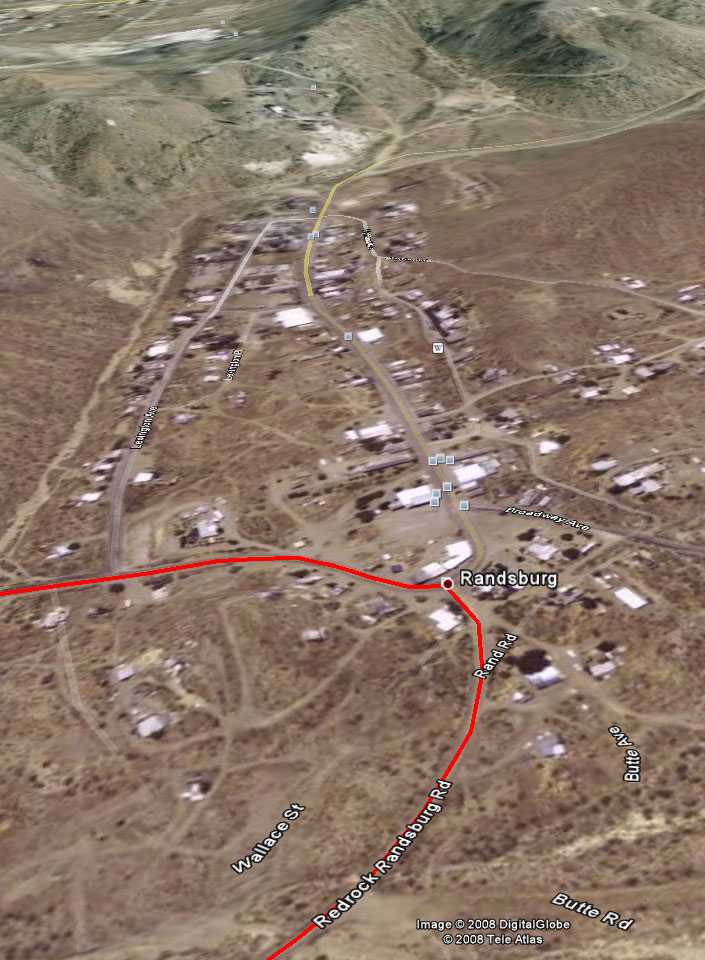
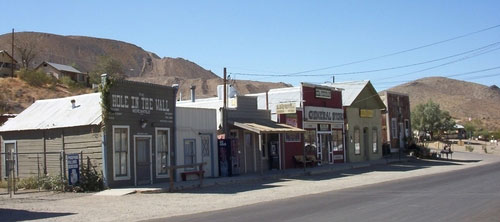
downtown Randsburg
(click to enlarge)
After riding through the hills North of Randsburg, you come to Route 395 and get on it heading South for a few miles - watch out for trucks! You ride through Johannesburg (which despite proximity feels nothing like Randsburg, it is modern and uninteresting), and then after a few miles turn left onto Trona Road. And enter the twilight zone...
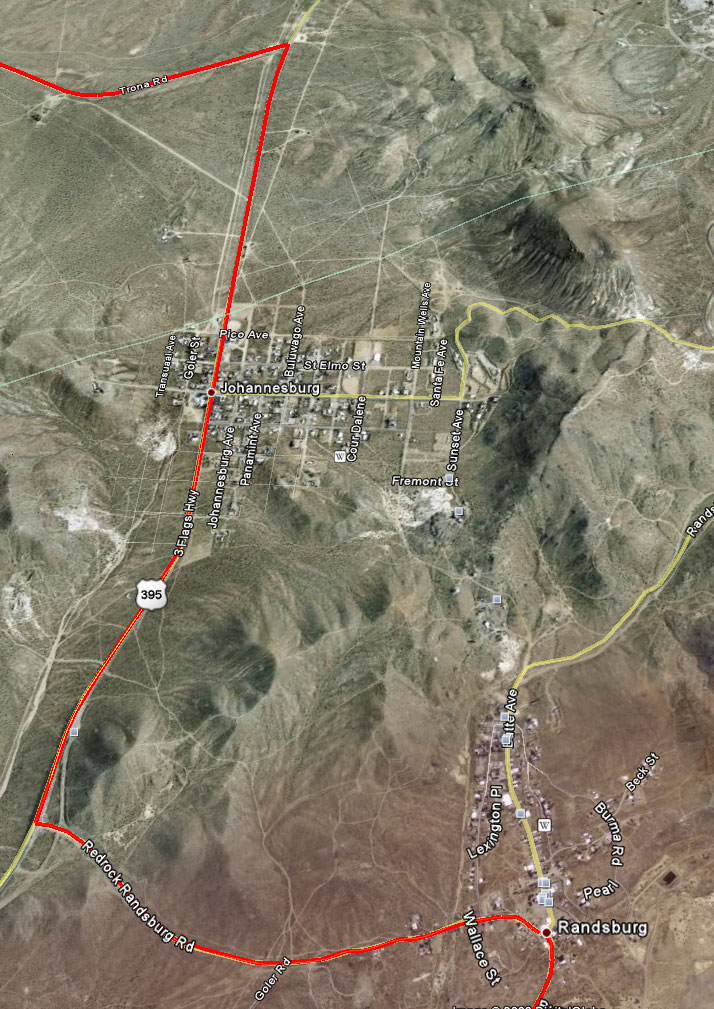
Trona Road winds through the mountains, going up and down and left and right for about 15 miles until you come to Route 178. I encountered more traffic than you might think, especially truck traffic, and the road surface is pretty lousy. This is going to be a tough section, but it is pretty interesting; each turn seems to bring a new view.
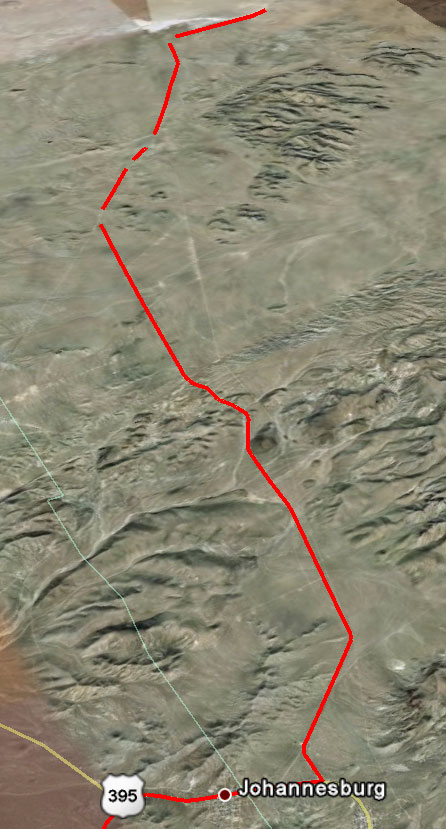
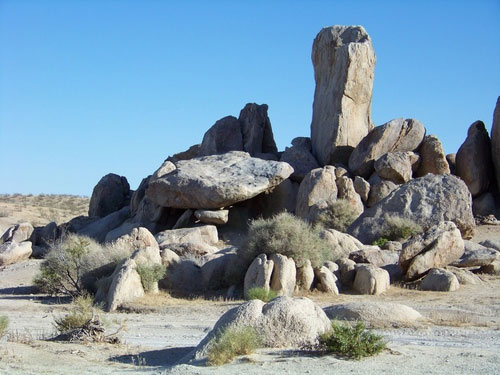
Wagon Wheel rock formation alongside Trona Road
(click to enlarge)
After turning right onto Route 178, the road improves and begins descending, and for about 15 miles you have rollers which are up and down but more down, until finally you descend into the Searles Valley. There is one really nice fast descent of about 2 miles right after you turn North, with the whole Searles Valley laid out in front of you, including Searles Lake. At the end of the descent there is a bike path next to the road, but it is in disrepair and I would simply ride the shoulder.
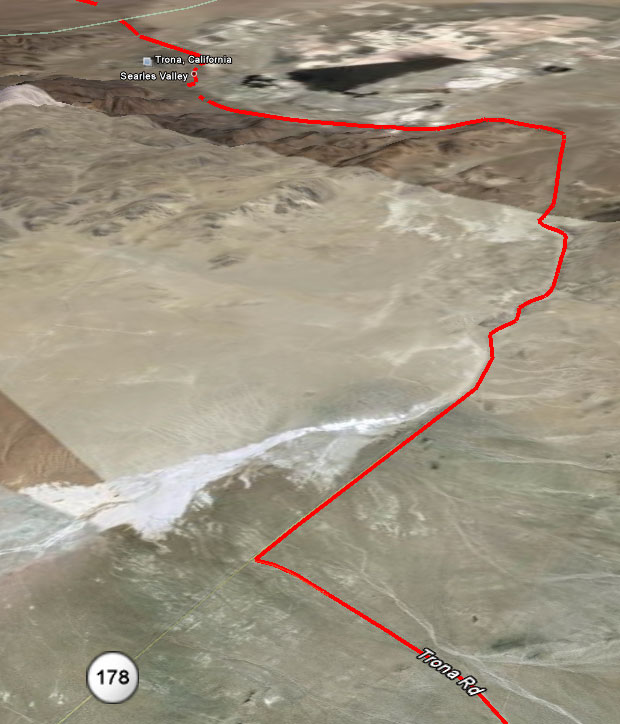
Trona has a long and interesting history, but from the main road it seems to be one giant chemical factory, with railways and quarries for decoration. (Trona is a chemical used to make Sodium Carbonate which is found in Lake Searles.) The town is in on the Lake Searles playa and is surrounded by pinnacles and other odd rock formations. The road through the town is straight, wide, and in good shape. There are quite a few trucks puffing along, though, be careful.
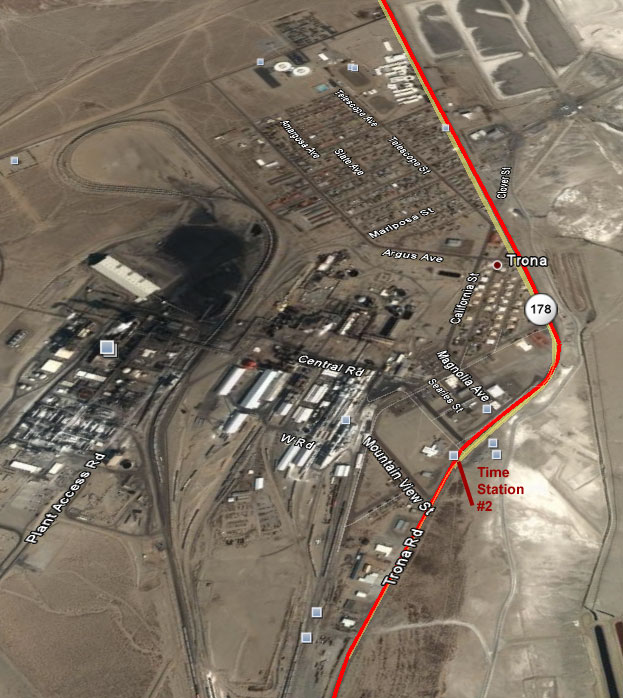
Time Station #2 is opposite a gas station in a dirt field. The gas station will be important, as it is the last place to get gas and supplies for a long time; given that you'll be riding through Death Valley at night there is nothing open at all. You basically have to plan that Baker will be the next time you can replenish.
Stage 3 - Trona to Furnace Creek (99 miles, 7,538 feet)
This is definitely the "queen stage" of the whole ride, with plenty of rollers, long flats through the desert, a massive climb, and a massive descent at the end down into Death Valley. And much of it will be ridden in the dark, whew. Not to mention an uneven road surface through the Panamint Valley (quite a bit of it has been repaved, but the shoulder is lumpy).
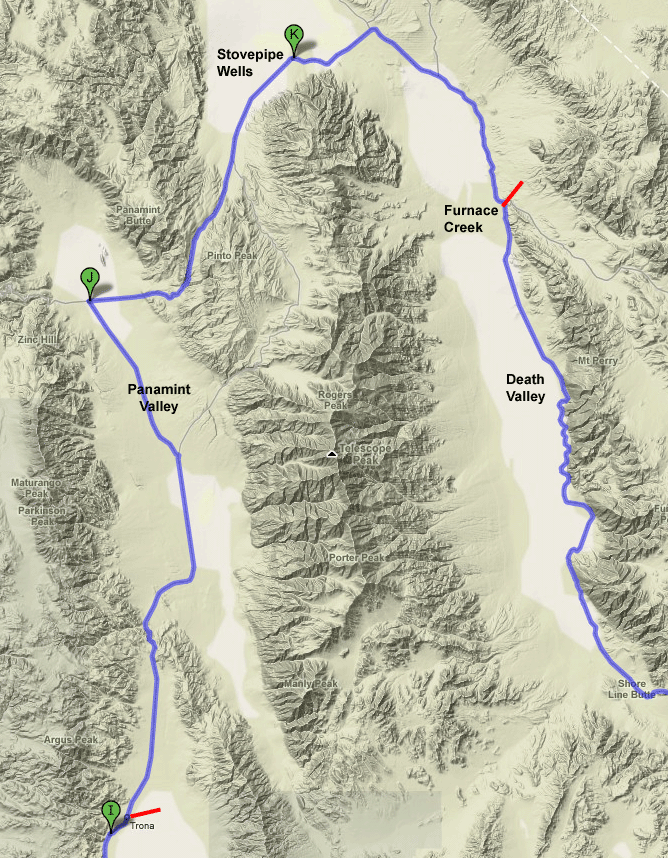
Stage 3 - route map
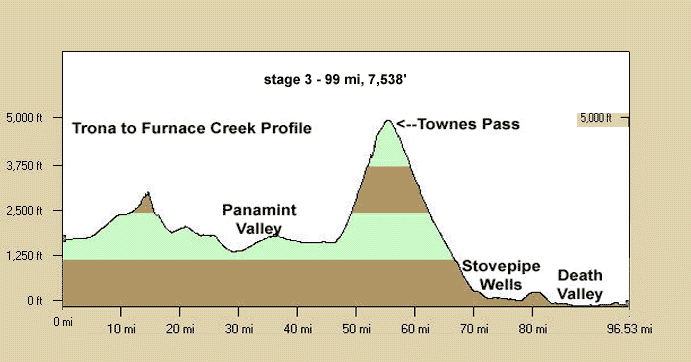
Stage 3 - profile
Heading out of Trona, you are on a straight road with a few rollers, heading for some hills off in the distance.
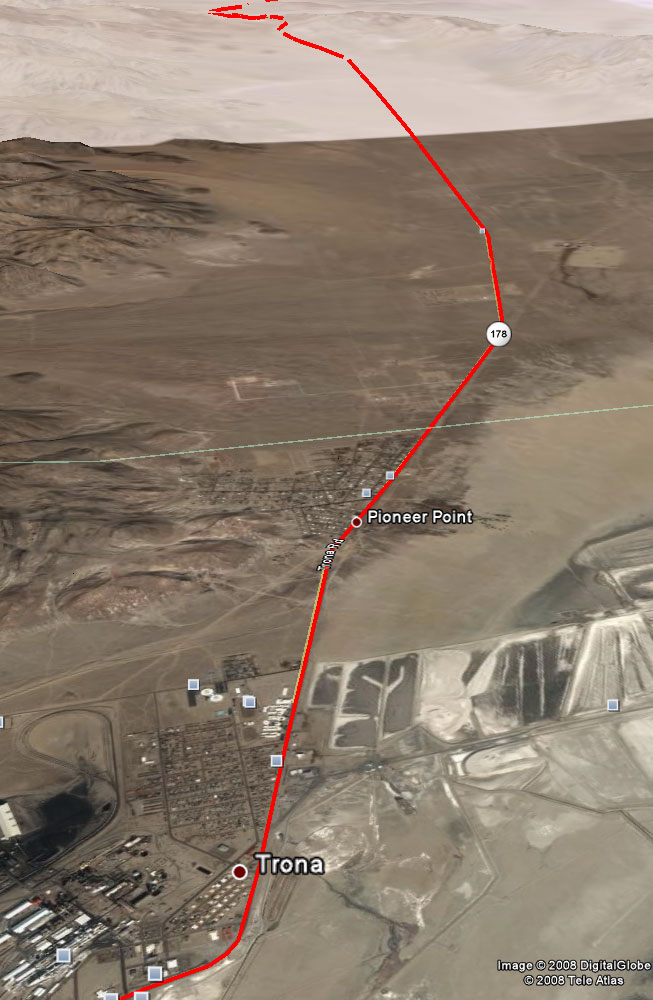
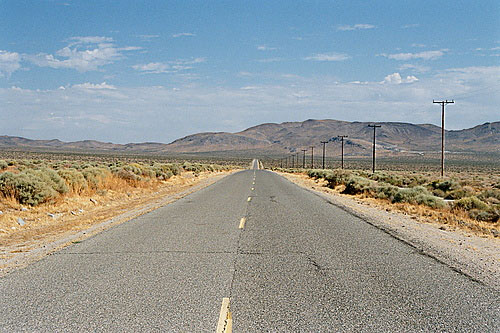
the road North from Trona
(click to enlarge)
The climb into the Panamint Valley (ka "the Panamint Bump") is nontrivial, with some rather steep sections interspersed with brief descents. The road has been resurfaced recently here, fortunately. There is no shoulder in places, and the road is narrow. There continued to be a surprising amount of traffic (at least in the middle of the day, a rider would likely encounter less as it is getting dark...)
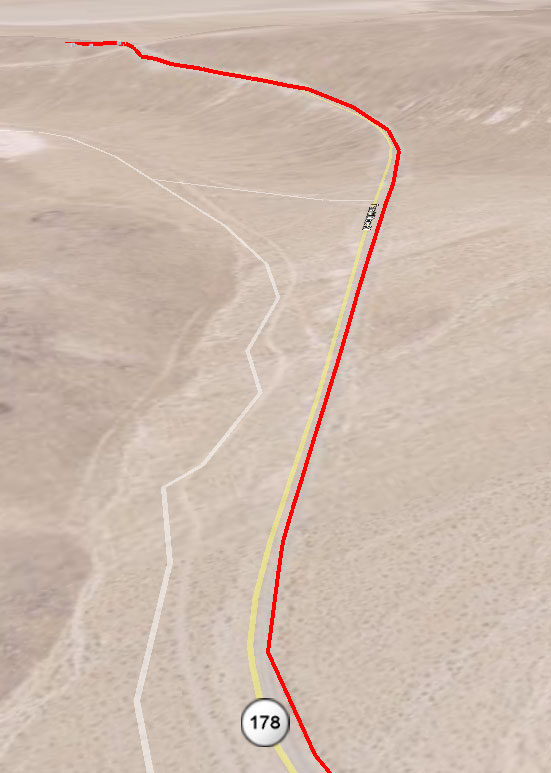
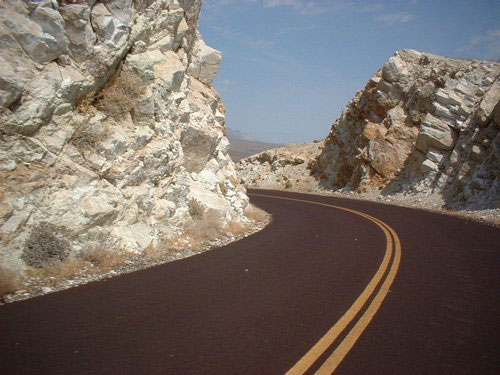
climbing the Panamint Bump into the Panamint Valley
(click to enlarge)

a Panoramic view of the Panamint Valley, looking North
(click to enlarge)
After climbing through the mountains there's a windy [reasonably] fast descent, and then lots and lots of straight rollers through the desert, mile after mile, for about 20 miles.
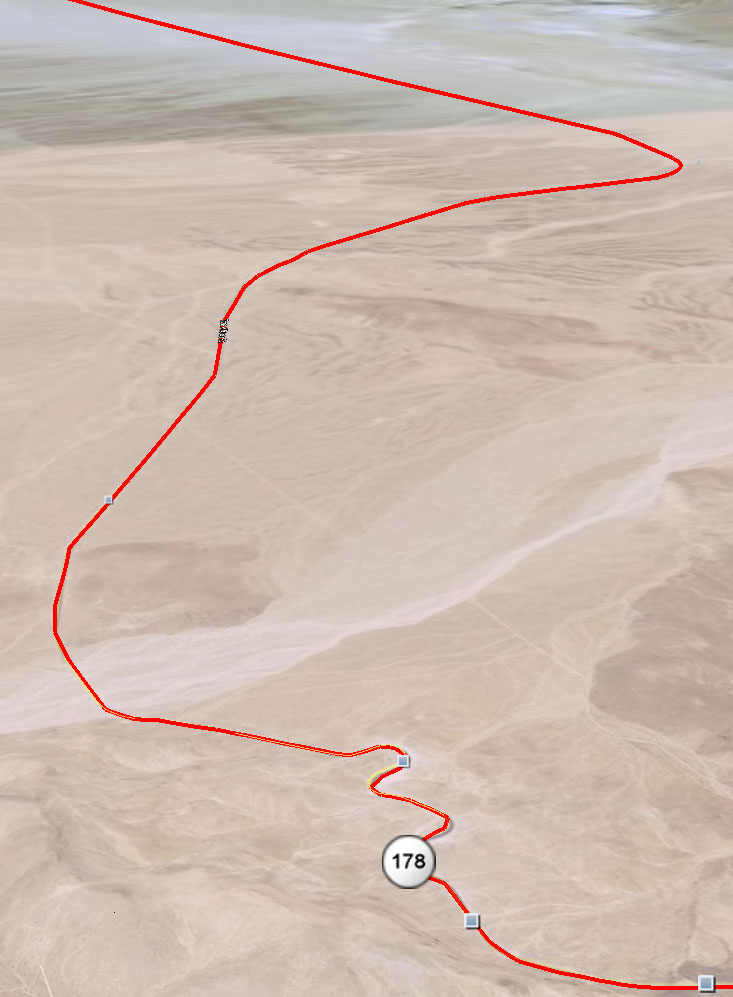
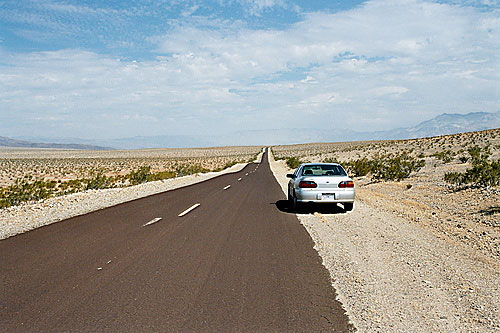
mile after mile of straight nothing, just rolling up and down
(click to enlarge)
When you come to Panamint Valley road, bear left, don't continue on 178 up to Wildrose. In the dark this will be an easy mistake to make, as well as a bad one :) The road will continue on for another 15 miles or so before coming to Route 190. There's a great sign, Lone Pine is 53 miles to the left, and Furnace Creek is 53 miles to the right. Yeah, 53 more miles.
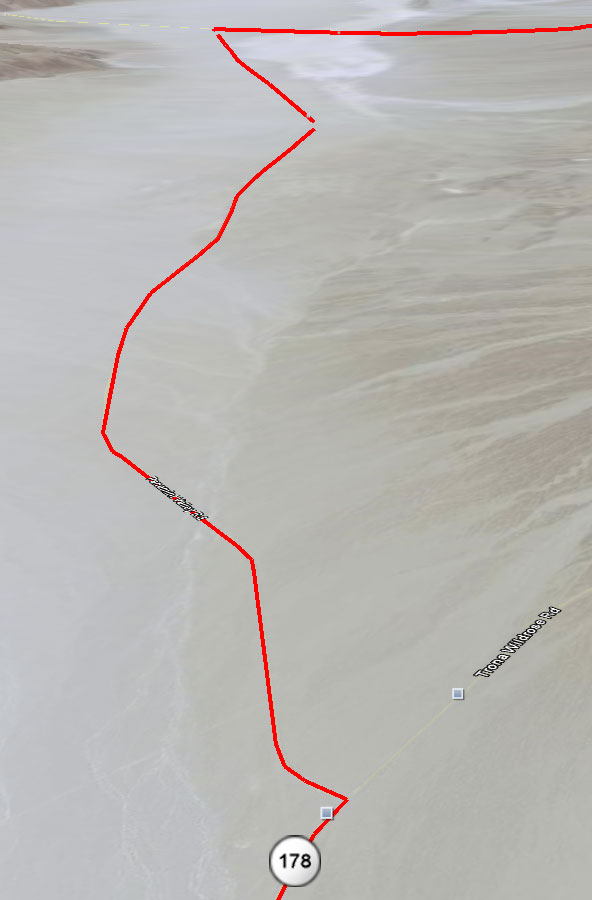
After the turn you will see big mountains rising dead ahead (or you would, if it wasn't dark, maybe that's a good thing :). And at the top of those mountains is the Townes Pass. This is the biggest climb in the whole ride, about 10 miles at 6%, I would say, with some sections over 10%. The summit is at 4,956 feet, the high point of the ride. It is going to take well over an hour to climb this, maybe nearing two. Compounding the difficulty it will probably be cold at night, too. At least the surface is good!
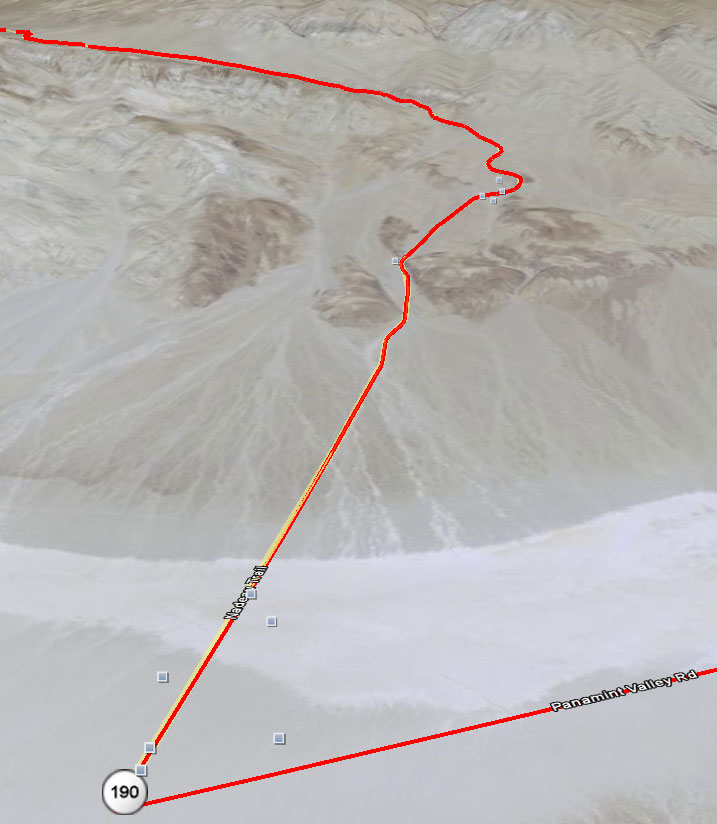
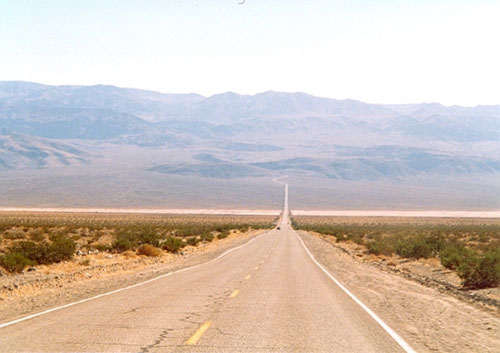
the approach to the Townes Pass; some objects are further than they appear
(click to enlarge)
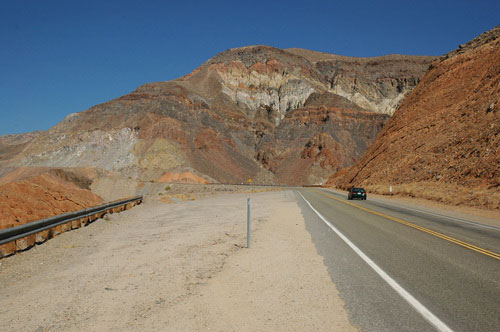
average of 6% for 13 miles, with some sections over 10%; wow
(click to enlarge)
After cresting Townes Pass (yay!) there is a long, long descent all the way down to Stovepipe Wells. If you had to climb this going the other way it would be the toughest climb in the ride, but you don't :) Instead you have a winding 7% grade for about 17 miles all the way from nearly 5,000' down to sea level, in the dark. Stay alert and have good headlights!
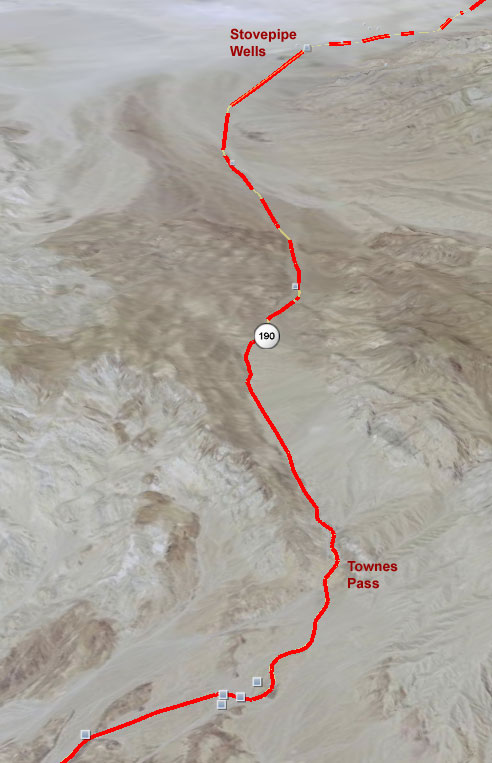
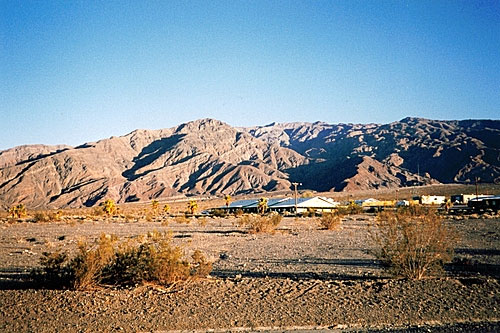
Stovepipe Wells - in daylight...
(click to enlarge)
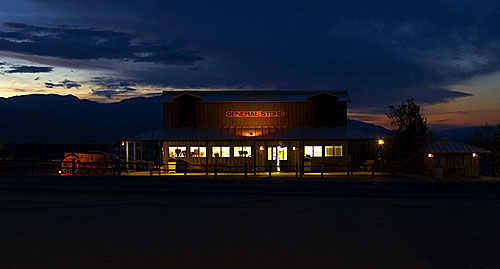
Stovepipe Wells - at night, the way you'll see it...
(click to enlarge)
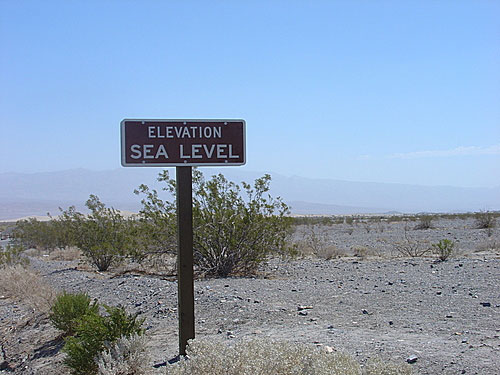
Elevation zero!
And finally the stage wraps up with a relatively flat section through the North end of Death Valley, from Stovepipe Wells to Furnace Creek. (There is a good little climb past the Scotty's Castle turn-off.) This is a beautiful area but you probably won't be able to appreciate it at night, barring a full moon... to the right is an area called Devil's Cornfield, featuring weird sand sculptures that look a bit like corn, and to the left are the famous Death Valley dunes. The road is wide and in good condition, with a nice shoulder.
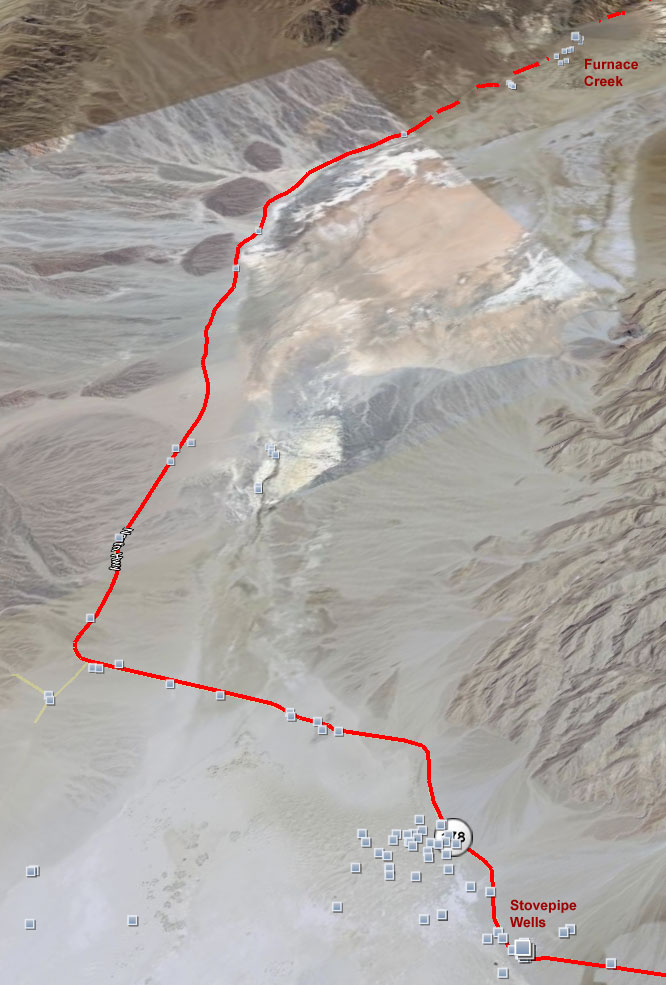
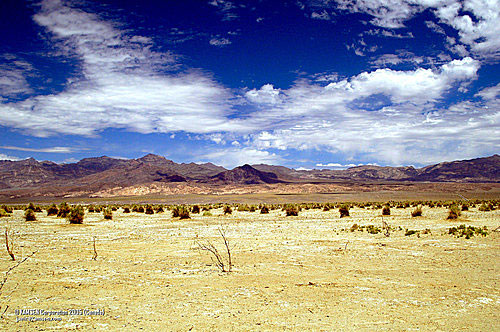
the Devil's Cornfield - off to the right of the road
(click to enlarge)
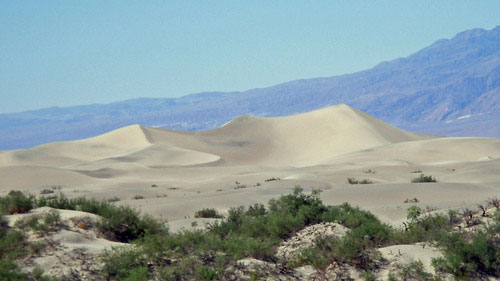
the famous Death Valley dunes - on your left as you leave Stovepipe Wells
(click to enlarge)
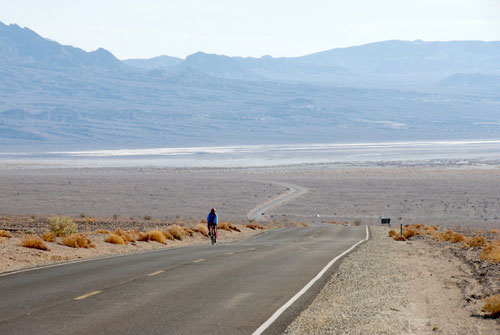
the road down to Furnace Creek
(click to enlarge)
Finally after 100 miles you arrive in Furnace Creek, probably in the dead of night. There will not be any facilities here, so you'll have to bring food, water, ice, etc. with you. It is possible to get "pay at the pump" gas all night to feed your SAG vehicles.
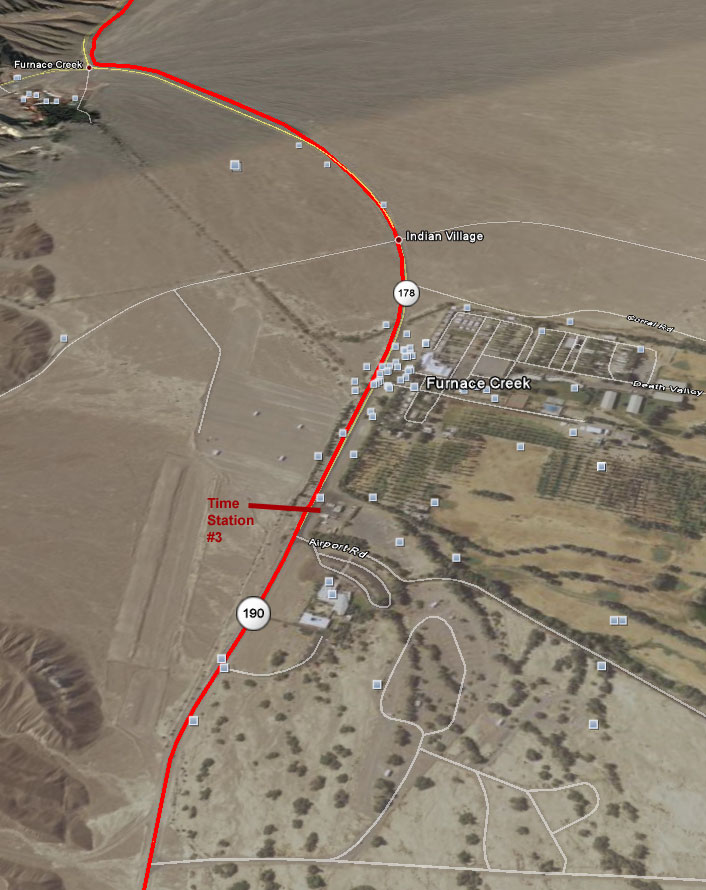
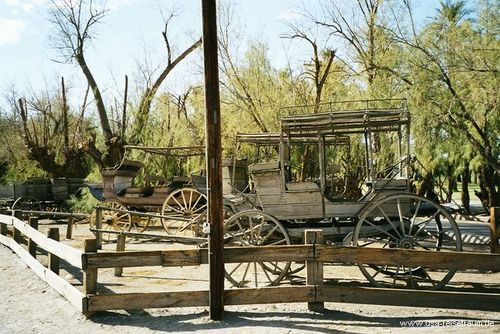
Furnace Creek history on display - may not see much at night, though
(click to enlarge)
Time Station #3 is just past the campground in a dirt lot next to the Chevron Station on the right just after the Visitor's Center. If you come to the Furnace Creek Inn, you've missed it. (An early version of this report had the TS in the wrong place; please see aerial view above for the correct location.)
Stage 4 - Furnace Creek to Shoshone (73 miles, 6,744 feet)
This is the second-toughest stage, long, ridden at night, and featuring the second-toughest climb and the second-longest descent. The roads at the South end of Death Valley are pretty crummy, too, adding to the fun. On the other hand this is the halfway point, after this it is all downhill, at least in terms of mileage :)
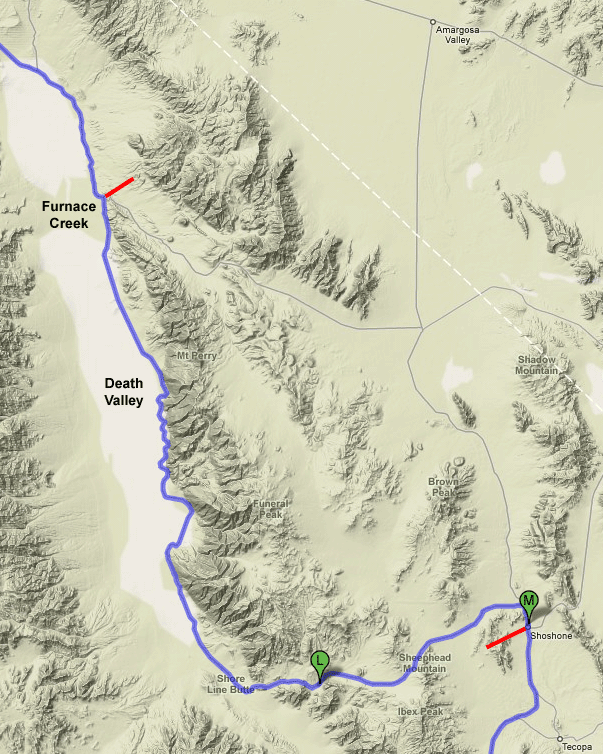
Stage 4 - route map
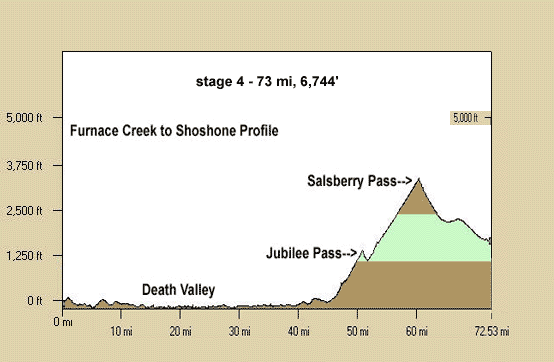
Stage 4 - profile
The stage begins with about 20 miles of rollers from Furnace Creek to Badwater. Just after leaving Furnace Creek you reach Badwater Road and turn right,. following Route 178 (Route 190 heads East into the mountains)... at this point the road gets considerably worse.
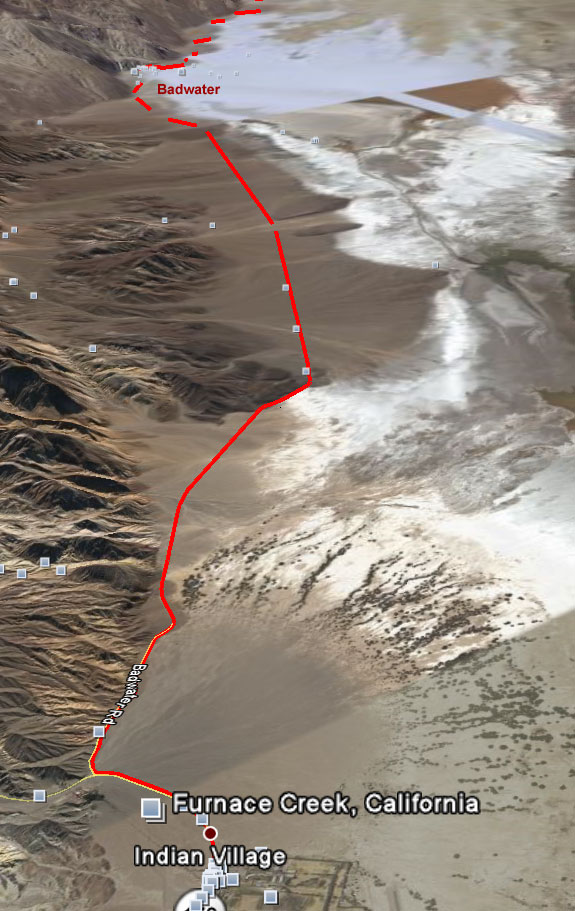
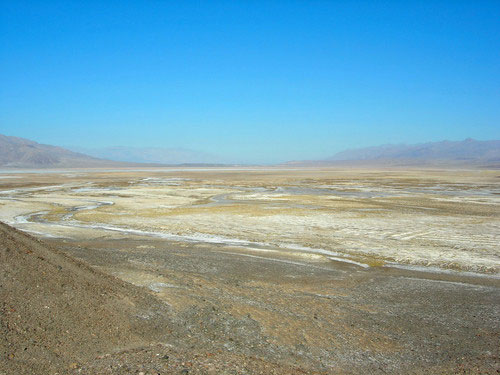
the Badwater flats, looking South from the hills to the East
(click to enlarge)
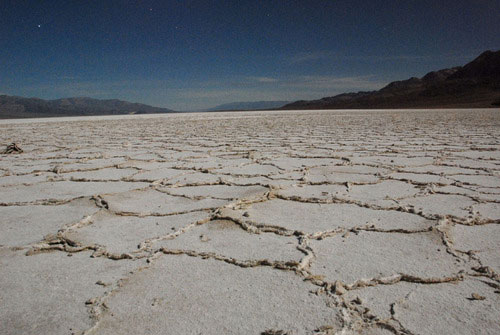
the Badwater salt flats, closeup in the moonlight
(click to enlarge)
Badwater is the low point of the ride, nearly 300 feet below sea level. (In fact it is the low point of any ride, being the lowest spot in North America :) It can get really hot here, but fortunately it will be early in the morning when you ride through here. From Badwater you continue on South on a pretty flat road for another 15 miles, before turning to the East to begin the climb up to Jubilee Pass. The road seems worse after passing Badwater, lots of ruts and potholes.
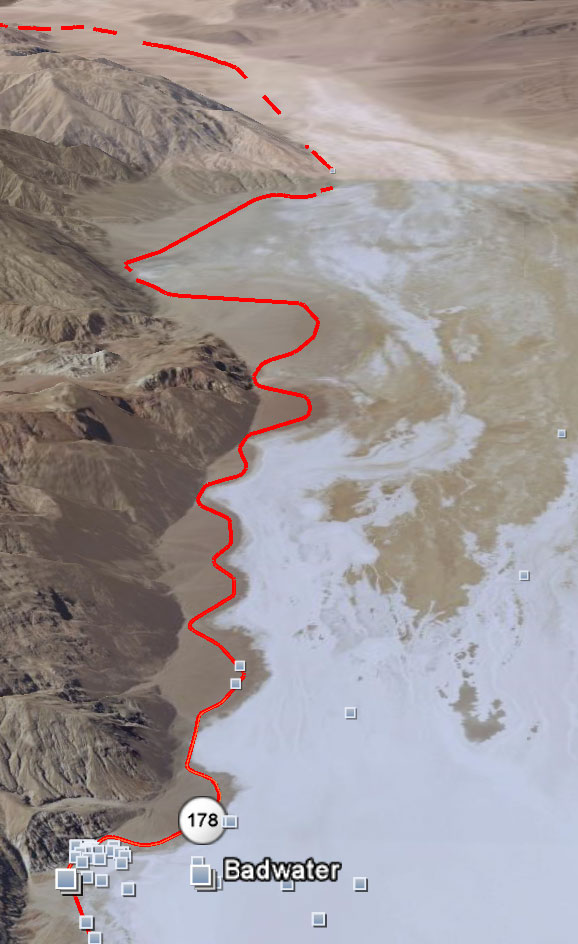
After turning onto Jubilee Pass road, the climb begins, gradually at first and working up to 6-7% in places. After about 5 miles you reach Jubilee Pass (1,285 feet) and then get a brief respite; a descent for about a mile. Then the road kicks up again and winds through the mountains for another 9 miles to Salsberry Pass (3,315 feet), the grade here is about 5%. From there you descend for about 15 miles gradually down into Shoshone. The road gets better after the Salsberry Pass and is fine down the descent.
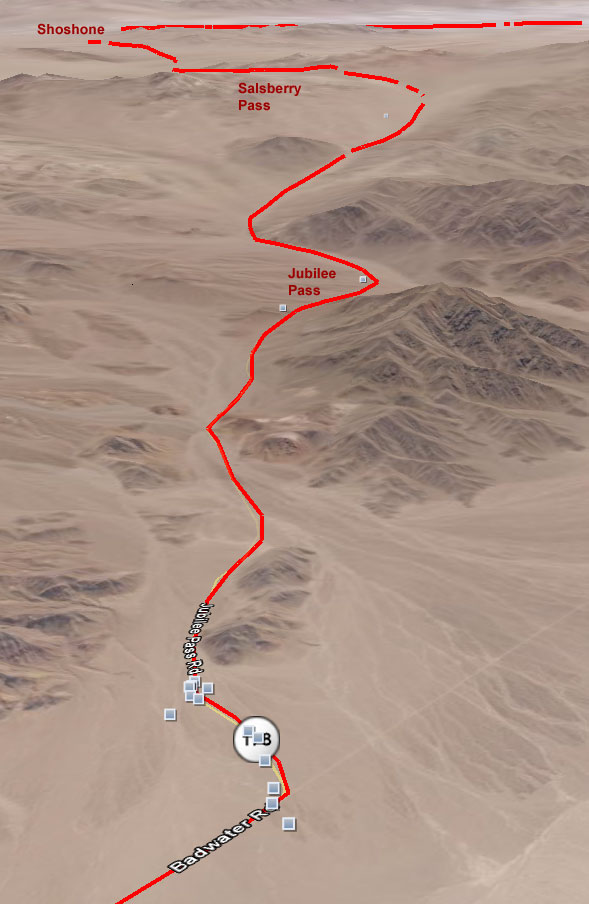
After the descent on Route 178 it joins Route 127 and you turn South, reaching Shoshone in a couple of miles. Yay. There isn't much to Shoshone, if you're going too fast you might miss it :)
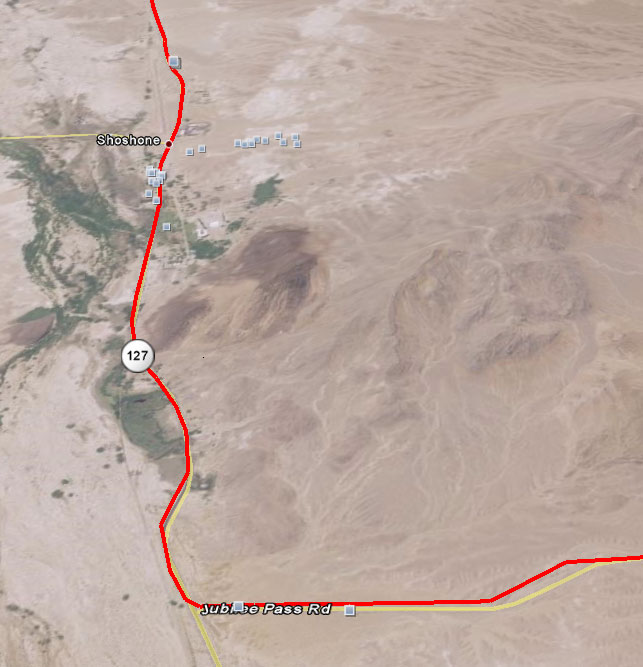
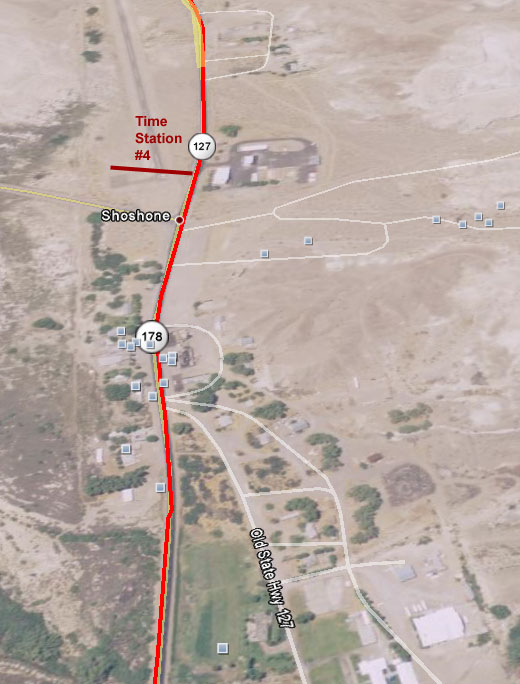
Time Station #4 is located on the right, just after a Chevron station. Depending on when you arrive in the morning, services may be available here (food, etc.), but you should probably plan to make it all the way to Baker. There is "pay at the pump" gas available all night.
Stage 5 - Shoshone to Barker (56 miles, 2,186 feet)
If there's an easy stage in this race, this is it; one gradual climb up to the Ibex Pass, and then a long, long descent down into Baker. When I drove through there was even a tailwind, YMMV. There are a few rollers but the road is mostly flat and in good shape. There may be some traffic.
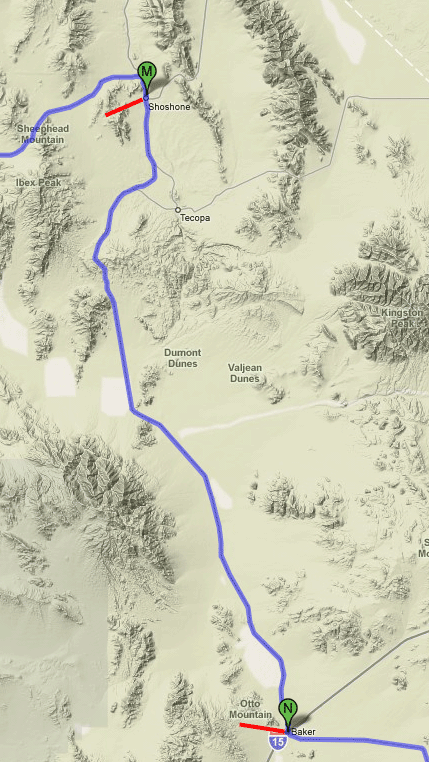
Stage 5 - route map
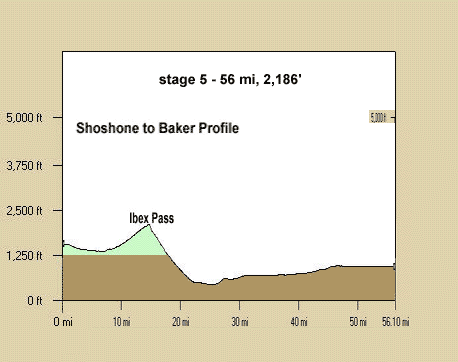
Stage 5 - profile
The stage begins with about 5 miles of flat, and then there's a false flat / climb up to the Ibex Pass over the next 5 miles or so. There are a lot of abandoned mines in this area, and as the sun comes up you might be able to look around and enjoy them!
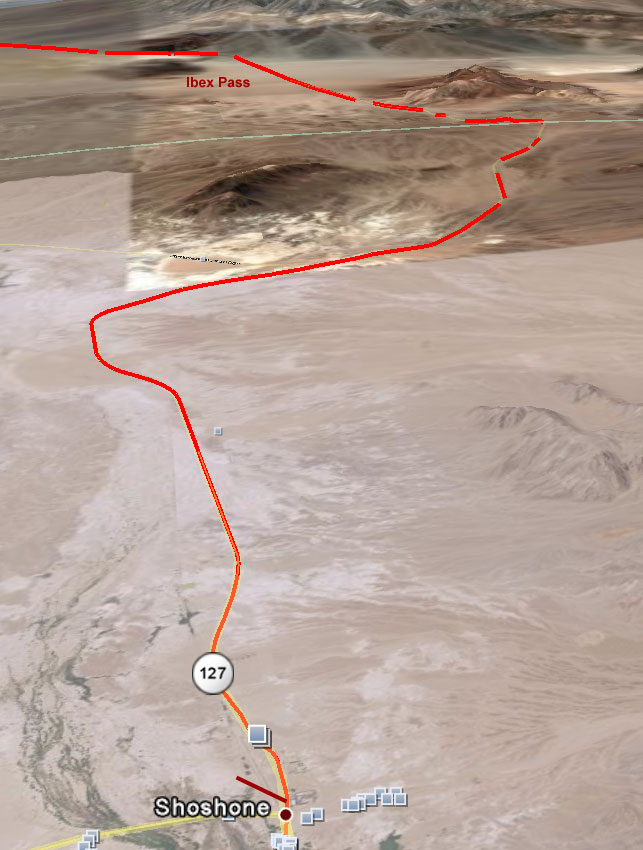
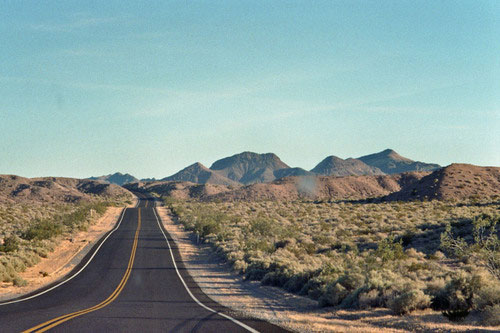
looking South on Route 127 - the road to the Ibex Pass
(click to enlarge)
After the Ibex pass it is all downhill to Baker - about 40 miles of rolling descent. Enjoy it while you can :) That is not a misprint by the way, you will be descending for over two hours - although it won't be coasting, you will have to pedal. Whew.
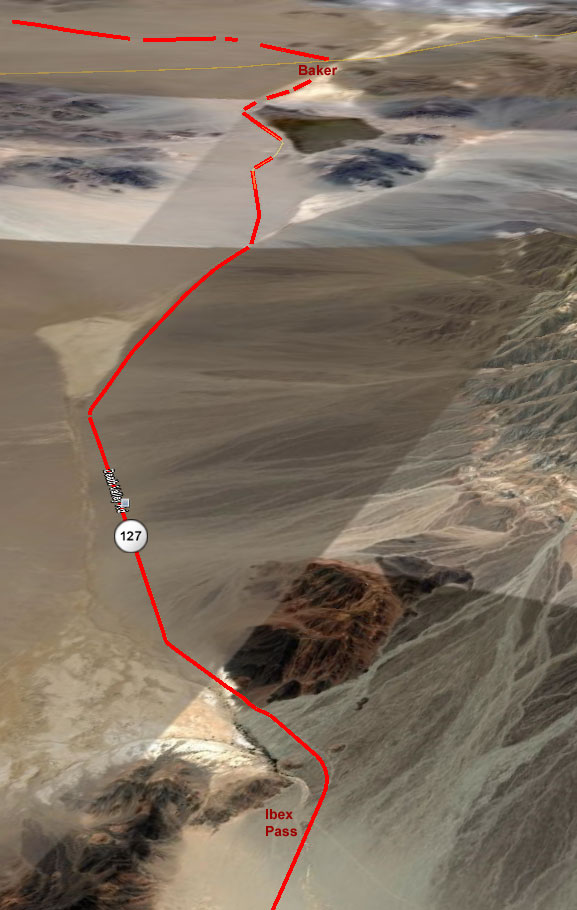
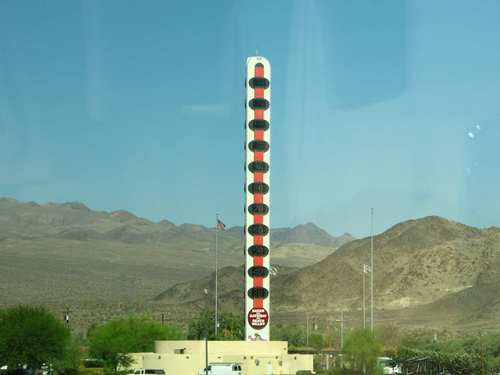
the "famous" Baker thermometer, "the largest in the world"
(click to enlarge)
Baker is the ONLY chance to stock up on gas, food, water, etc. before the finish; there is nothing in Kelso or Amboy. It is a cute little town on Interstate 15, billing itself as "the gateway to Death Valley". Much of the town feels 1950s-ish.
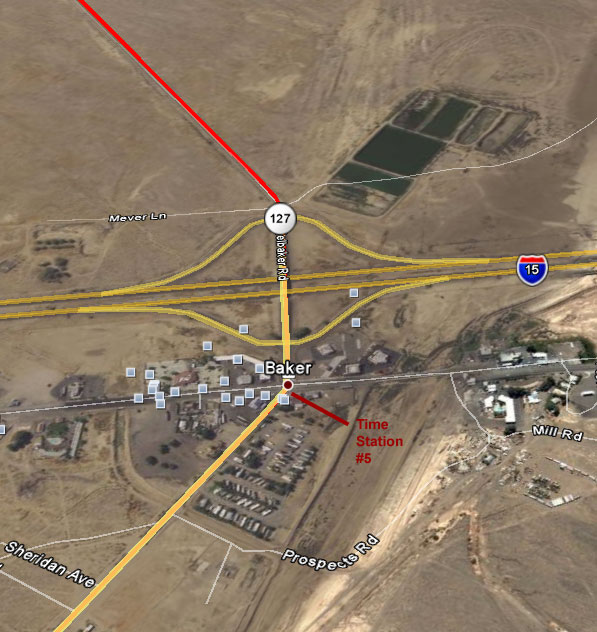
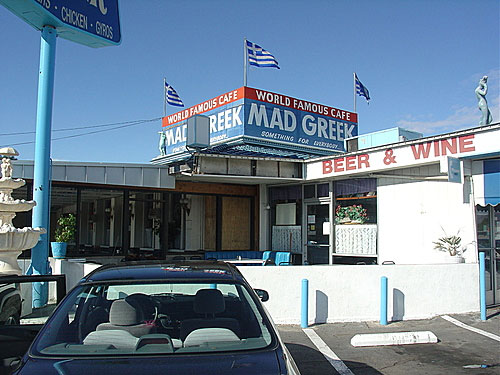
the "world famous" Mad Greek restaurant (across from Time Station #5)
(click to enlarge)
Time Station #5 is on the right, a paved lot across from the Mad Greek restaurant, pretty much in the center of Baker (just before reaching Interstate 15).
Stage 6 - Baker to Kelso (35 miles, 2,920 feet)
This is the first of two short stages in and out of the Mojave National Preserve - all desert. You will climb 2,000 feet gradually over 25 miles, then descend for about 10 miles into Kelso.
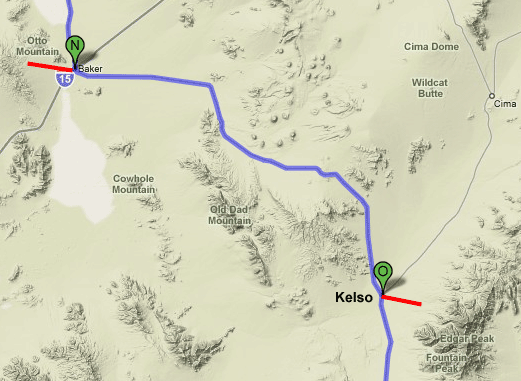
Stage 6 - route map
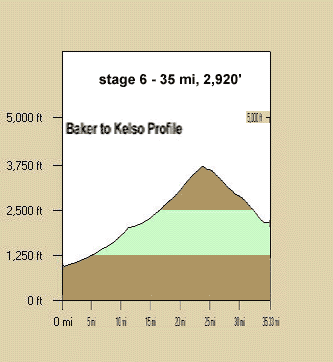
Stage 6 - profile
You go straight South from Baker on Route 127; the road here is straight and flat, the surface is good. There are volcanic cones along the climb to the left, and mountains to the right with mining ruins (Kelso is an old mining town). It is going to be hot and getting hotter.
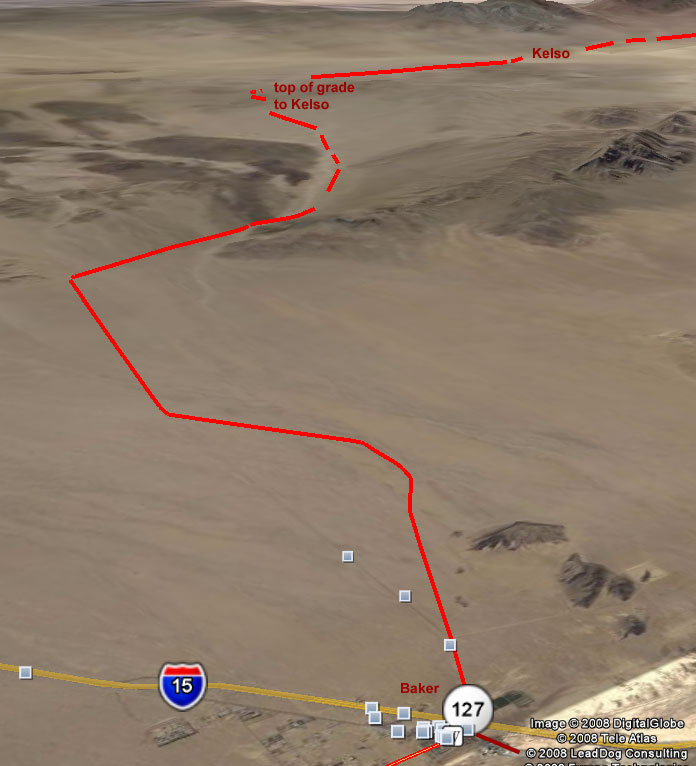
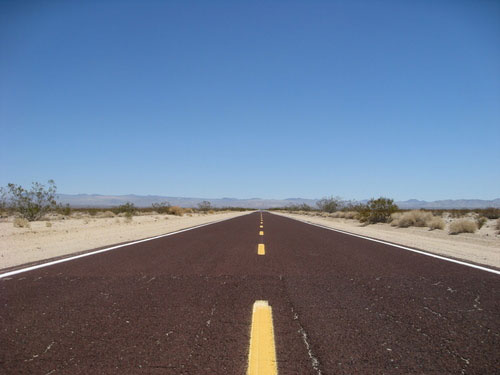
looking South from Baker on Route 127 - Kelso in the distance...
(click to enlarge)
The descent down into Kelso is gradual, flat, and straight... Kelso is nearly abandoned, an old mining town on the railroad now sustained by tourists; there is an outstanding National Monument Visitor's Center.
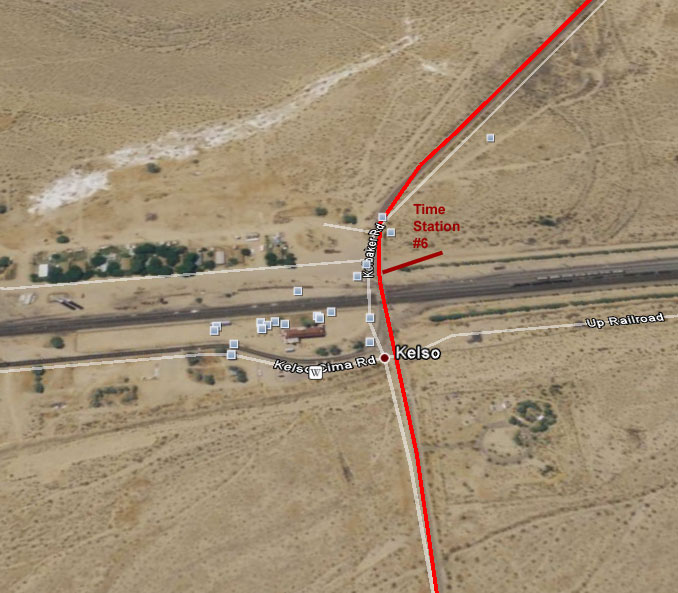
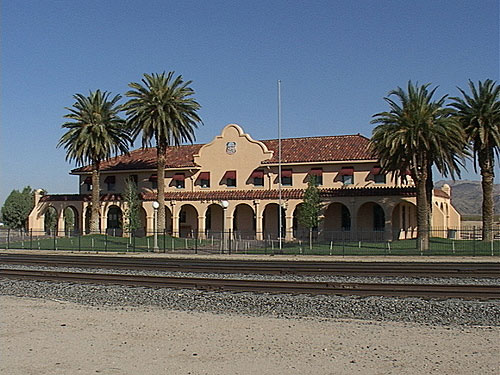
the [restored] Kelso Hotel, along the railroad tracks
(click to enlarge)
Time Station #6 is on the right, just after crossing over the railroad tracks. There are basically no facilities in Kelso, plan on having enough gas, food, water etc. to make it to the finish from here.
Stage 7 - Kelso to [almost] Amboy (34 miles, 2,280 feet)
The shortest stage but not the easiest, with a grueling climb out from Kelso and then a long fast descent down to Amboy.
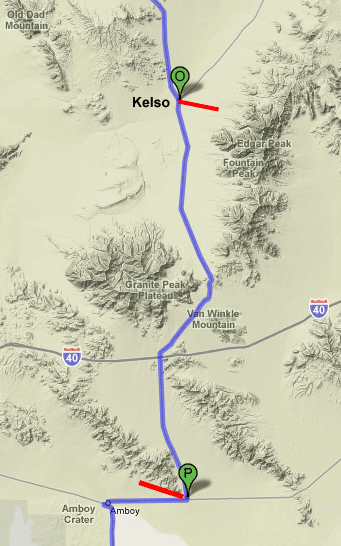
Stage 7 - route map
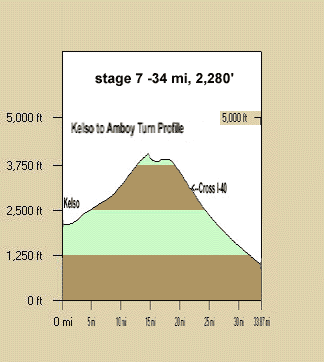
The climb out from Kelso into the Granite Mountains is about 2,000 feet spread over 15 miles; a gradual but continuous ascent. It should be nice and hot for this stage, mid afternoon on Sunday. (Well, depending on your schedule; some riders will get here in the dark...) The road quality is good. The Granite Mountains are interesting and present a different look to the other mountains in the area, which is good because you'll be looking at them for a long time...
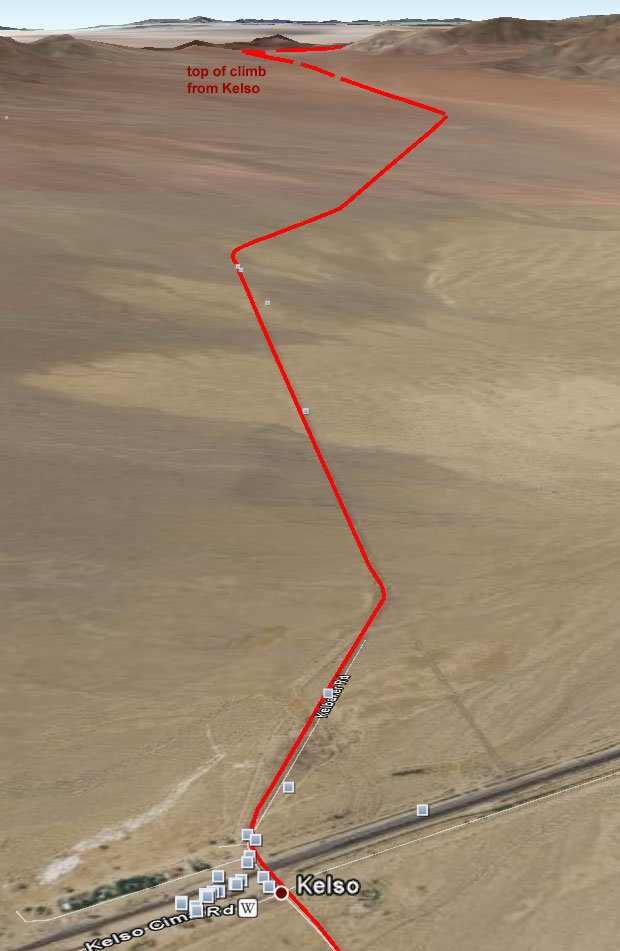
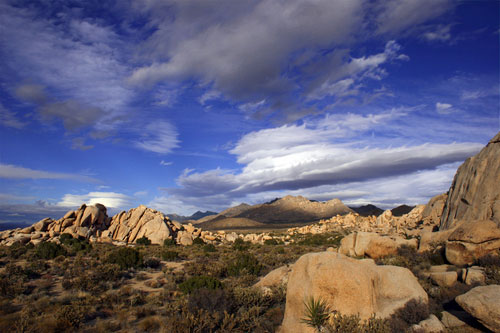
the Granite Mountains
(click to enlarge)
The descent from the Granite Mountain summit down into Amboy is pretty steep, losing 3,000 feet over the course of 20 miles, with some sections of rough road. This is going to flash by after the long climb up to the Granite summit.
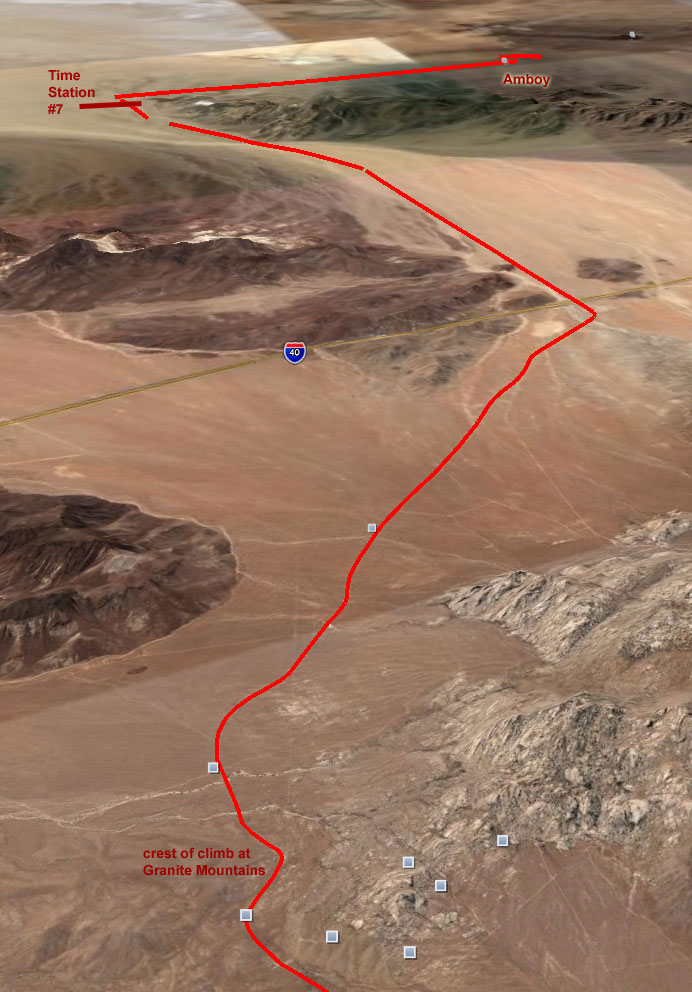
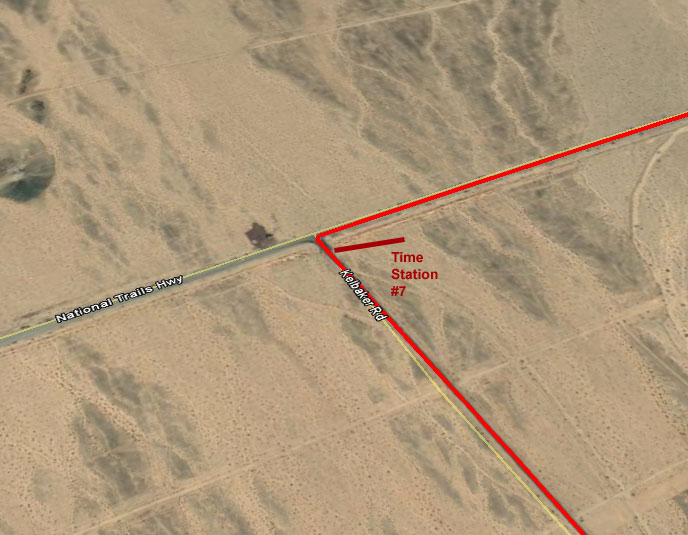
Time Station #7 is on the right just before you reach the National Trails Highway (formerly known as Route 66)!
Stage 8 - Amboy to 29 Palms (58 miles, 4,170 feet)
The final stage, and it isn't easy; at this point in a two-day adventure it will feel brutally long, and there is a decent amount of climbing, with a fairly steep ascent in the middle and then a long false flat to the finish.
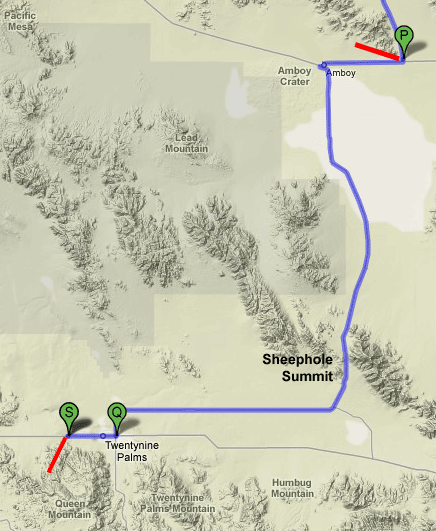
Stage 8 - route map
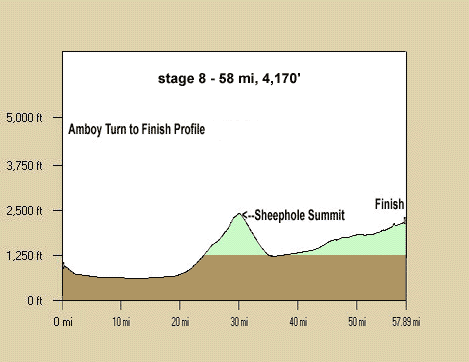
Stage 8 profile
You start by passing through Amboy, which is a shell of its former self when it was a way station on Route 66. Some real Americana here... There are no services available in Amboy. Be careful not to miss the left turn after leaving Amboy, Route 66 is cool, but finishing the 508 is cooler!
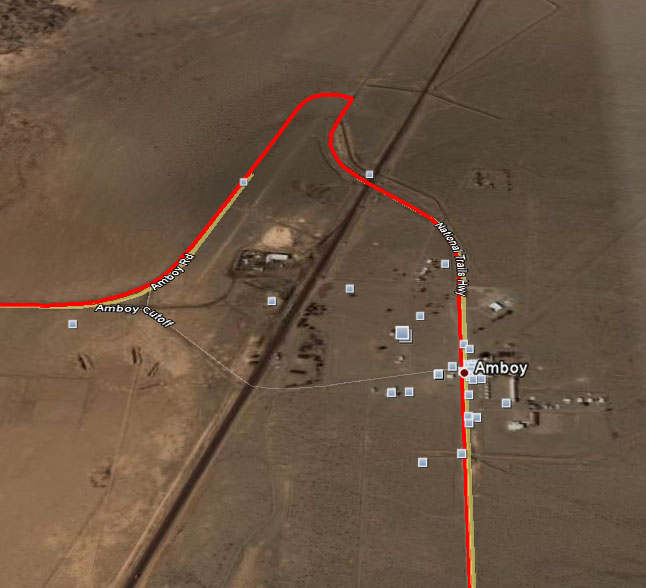
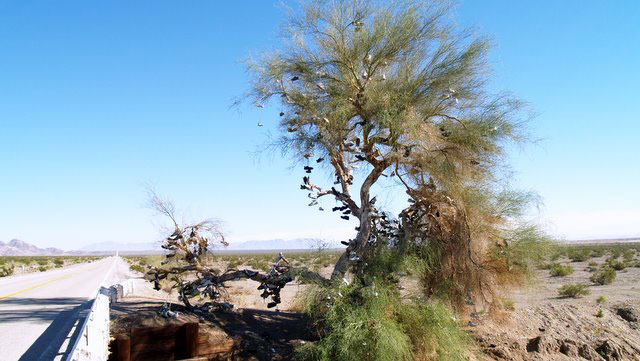
Shoe tree along Route 66
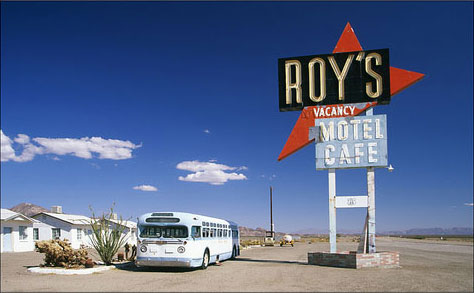
Roy's Motel and Cafe in Amboy - a Route 66 landmark
(click to enlarge)
Heading South from Amboy, you go for about 20 miles due South through the desert before coming to the climb up to Sheephole Summit. Even in a car this seemed like a long way. The ascent is about 8 miles, at about 5%, getting somewhat steeper at the top.
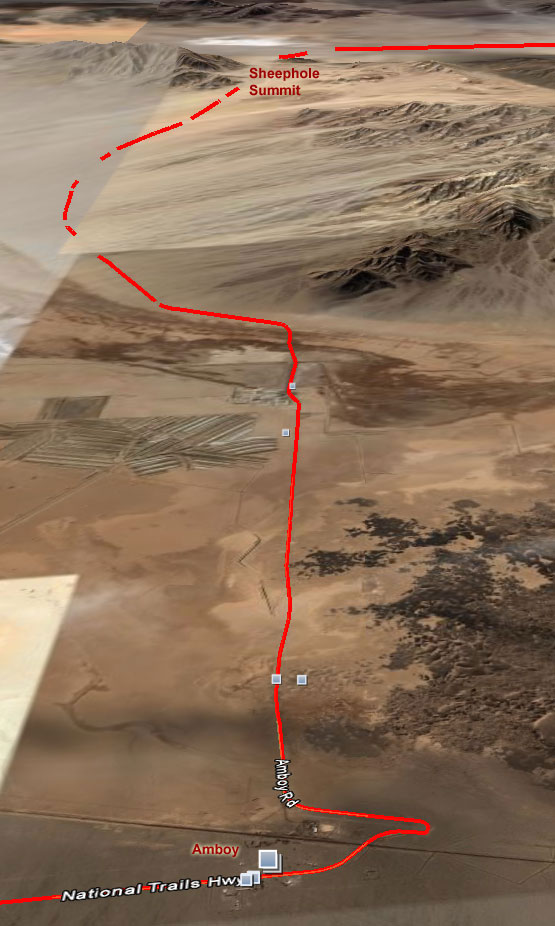
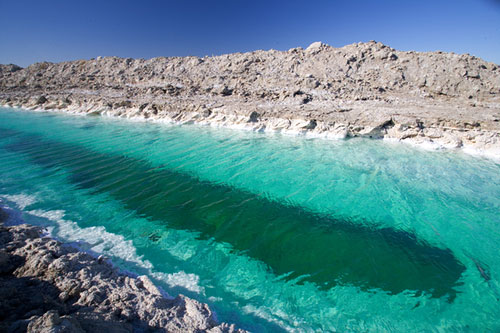
some amazing salt flats along the way South of Amboy
(click to enlarge)
After cresting Sheephole Summit there's a steep descent down the other side, over about 5 miles. At the bottom of the descent the road turns West and heads across the desert to 29 Palms.
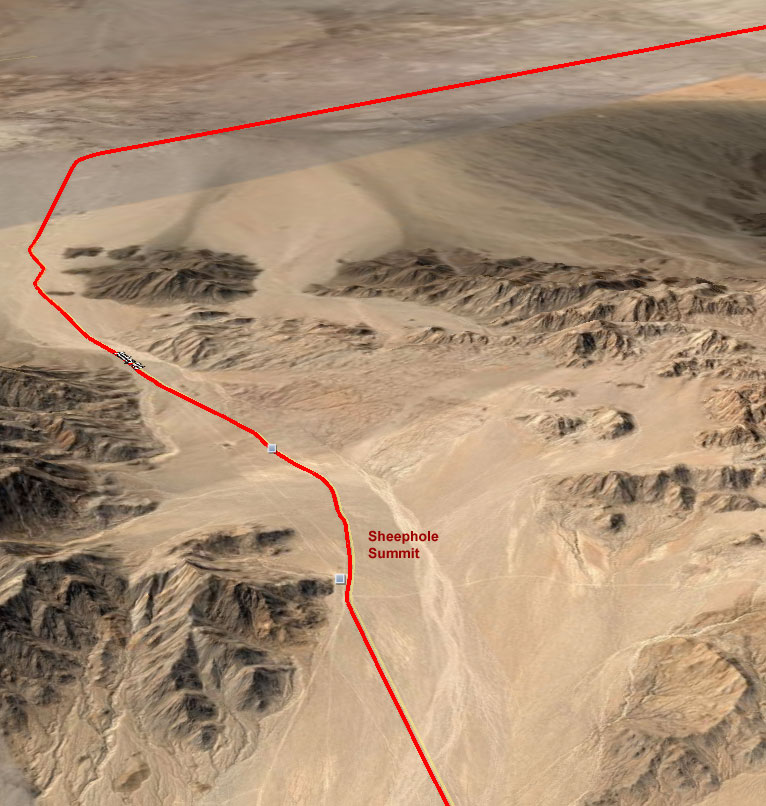
Now you have 20 miles straight West, with a slight grade upward, and [possibly] a headwind. This is going to seem like it takes forever... Yuk. The road is straight as an arrow with rollers, the surface is not very good until you get near 29 Palms where it has been recently resurfaced.
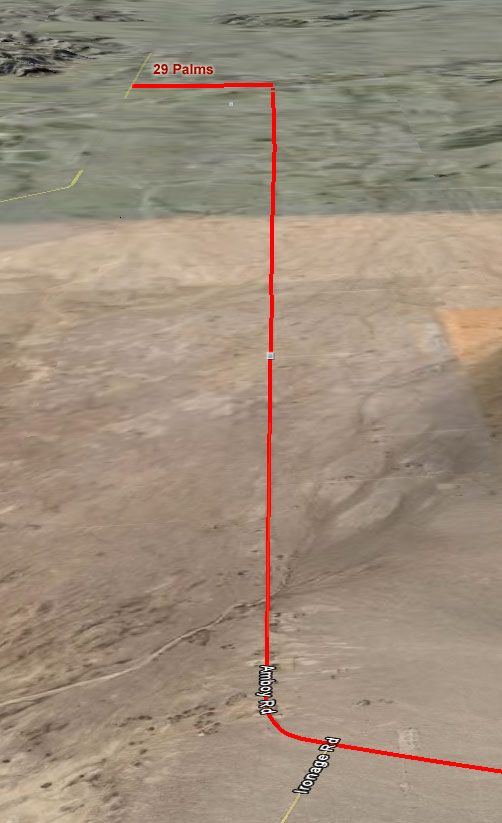
Finally as you get into civilization (!) you turn left onto Utah Trail, and then right onto 29 Palms Highway. After about 5 miles through the town of 29 Palms, you turn left on Panorama Avenue and reach the FINISH. If you are riding as a team, the whole team can finish together. Congratulations!
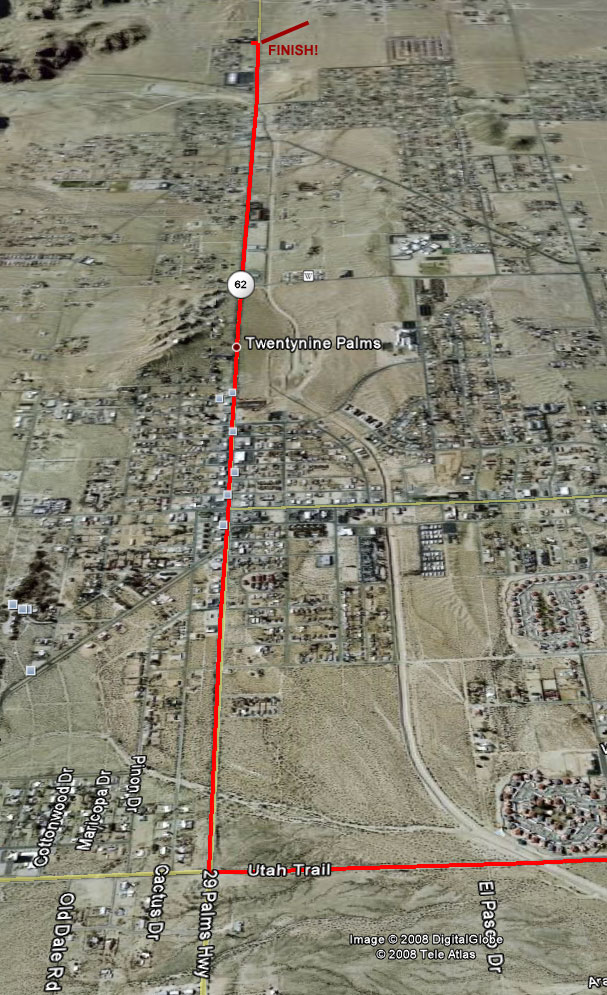
The finish is at the Best Western Hotel on Panorama Avenue, under the awning at the front door.
Projected Schedule
I've modeled a likely schedule for riding the 508, based on a given average speed. The model is contained in this spreadsheet in case you're interested, and here is a summary:

You can see that an average of 13mph would yield an overall ride time of 39 hours, which means you'd finish at around 10:00PM on Sunday evening. The times are significant because of temperature and light; Stage 2 will be hot, Stage 3 will be cold and dark, Stage 4 will be colder and darker, Stages 6 and 7 will be hot, and Stage 8 will get cooler and darker...
Final Thoughts...
The overall ride is much harder than I thought. Not only is it 508 miles, but there is a lot of climbing, and a lot of rollers when the road isn't climbing. For large portions of the ride the surface is not very good. It will be hot during the day, and cold at night. The physical challenge is significant.
However there is also a non trivial psychological challenge; keeping your head in the game for such long distances. Riding 20 miles across desert is not the same as riding 20 miles in town, with interesting stuff to hold your visual interest; there are long stretches of desert, seemingly mile after mile of similarity... You can often see the endpoint way off in the distance; so you'll be riding for hours looking at the road stretch on ahead into the horizon. It might be hard to remain focused and find a mental zone which will allow these long distances to be traversed. Still I haven't done it - yet - so I'm open to the possibility that there will be a lot more variety on a bike than there was in a car. Nobody who has ridden the race has ever called it boring!
| 



